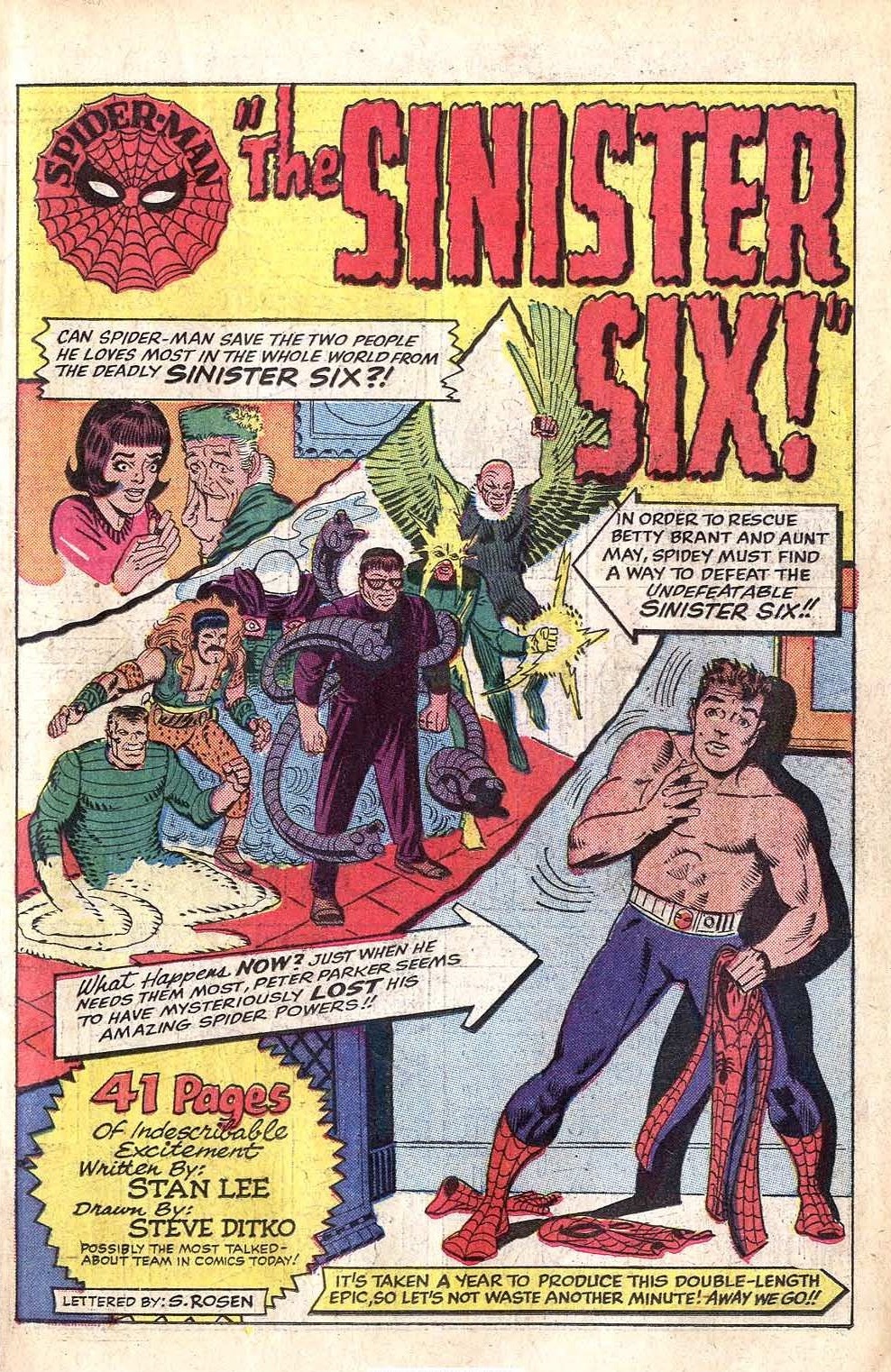Our Blog is the best in different types of comics and funny stories read our latest different types of comics and funny stories and high in searches in google browser.We gives you a different types of comics and funny stories with best reading and watching features.Thanks for our all the viewers in coming our blog for watching or reading comics and watching funny stories. #Comedy And Funny Status thanks to all the viewers.
Saturday, 4 July 2020
Panel(s) of the Day #866 (Caturday!)
Well, I’m convinced.
Amazing Spider-Man (Vol. 1) #205
Published: c. March, 1980?
Cover Date: June, 1980
“…In Love and War!”
Writer: David Michelinie
Artist: Keith Pollard
Inker: Jim Mooney
Letterer: Diana Albers
Colorist: Carl Gafford
The post Panel(s) of the Day #866 (Caturday!) appeared first on Spider Man Crawlspace.
from Spider Man Crawlspace https://ift.tt/2C1CUWt
https://ift.tt/2Z2kmyy
Spidey Kicks Butt: JR’s Top 10 Spider-Man Stories
I originally wrote this article back in 1999, it has been the most frequented article on my website. I’m not sure why, because there are some I feel are much better written – maybe it’s just the idea of people already knowing what they like, and they want to see whether or not this fool who calls himself MadGoblin agrees with them, or whether or not he really is as clueless as he sounds about what makes a good Spidey story.
As a result of my recent relocation to the outskirts of a major metropolitan area, for the first time I have the infinite pleasure of having several comic book shops to choose from and peruse their back issue files. Ever since the market collapsed a few years ago, many back issues are dirt cheap, and every store seems to have a bargain box where you can pick up stuff for fifty cents or less, as long as you’re not anticipating finding classic storylines or stories by popular artists or writers (although I am starting to see some slight upward movement, as well as a thinning of stocks in certain titles).
After I had plugged several gaps in my collection, I decided to take another look at my Top 10 to see if any revisions were merited – and as of September 19, 2000 – the Top 10 remains undisturbed, although I did revise my analyses of those 10 to reflect some new perspectives. But, that could change anytime….
Obviously, anyone’s Top 10 list is completely subjective and prone to bias and illogic, and mine will be no exception. An article in Wizard’s Spider-Man Special just prior to the reboot in November, 1998 inspired this effort – but I was relieved indeed to find out that we duplicated only three storylines. I really don’t want to be in a position of agreeing with Wizard on too much.
I probably will review this article once again next year, and revise and expand it somewhat to include a Worst 10, as well as others that may not make the Top 10, but are certainly worthy of merit.
Anyway, in order to prepare to write the article, I simply sat “After collecting Spider-Man comics for almost 30 years (yes, it really has been that long – scary, huh?), which stories do I simply remember without having to reread everything?” Ten came to mind fairly quickly (actually 11 – but I left one off for reasons I’ll discuss below in the “Notable Exceptions List”. None of these lists are in any particular order. All of the stories presented are simply either great for reasons of great storytelling, the use of favorite concepts, or they take me back to a time in my life that I’ll always remember.
1. Spectacular Spider-Man 78-79 “The Long Goodbye”
This was the conclusion of a storyline that involved the Black Cat, Doctor Octopus and the Owl. Spider-Man and the Cat foil Doc Ock’s plan to blow up New York City in Spectacular #75, but not before the mad doctor critically injures her. Enraged at Ock’s brutal beating of the Cat, Spidey decides to stop playing Mr. Nice Superhero and puts Ock down hard by literally ripping those famous mechanical tentacles off from the doctor’s body (a move so obvious and so easily done in this story – it defies logic that Spidey hasn’t done this before or since.)
Our hero’s victory is short-lived as in issue #78, Ock is on the loose again, and the Cat is fighting for her life in the hospital. Spider-Man knows that the doctor is going to try to finish the job on the Cat first, and as a bonus, permanently settle the score with the webhead as well. Realizing that this could very well be Spider-Man’s last stand, Peter Parker decides to make the rounds of family and friends, tying up some of the loose ends in his life in the event the fight with Octopus becomes a true fight to the death. He parties with his closest friends, makes sure that Aunt May knows without a doubt that he loves her, in a rare display of self-confidence, extorts more money out of the notoriously cheap Jonah Jameson for his photos, and tells his colleagues at graduate school that there’s a lot more to life than grades and academic honors. This story is also one of the few times that Doctor Octopus’ character seems to be right on the button, an arrogant warped, jealous, bitter little toady of a man whose anger and mechanical arms have made him a monster. The suave, urbane Octopus that appeared in the Clone Saga, and the unlikely romancer of Aunt May in the mid-70’s are examples of how inconsistently one of Spidey’s greatest nemesis has been portrayed. Interestingly enough, a recent example of another good portrayal of Doctor Octopus was in the well-done Death and Destiny limited series.
This story really resonates as you can almost literally feel Spidey falling in love with Felicia. It’s very tangible, very potent – his desperation when she is literally on death’s door – his horror as the doctors have to cut her open to stimulate her heart. It just seemed very strong to me back when I was an impressionable young man in college who was always losing his heart to one pretty girl or another, and now as an old married man, it’s almost kind of sweet and sad in a way that it’s been a long time since I’ve fallen that fast and that hard.
Which is one of Spidey’s appeals. When he falls, he falls hard. And he’s not a playboy. In 40 years, long time fans can count on one hand the women he’s really loved (1) Betty (2) Gwen (3) Mary Jane and (4) Felicia. Mary Jane is the compromise between Gwen and Felicia. She can be wild, but not amoral, free-spirited, but completely trustworthy.
Doc Ock is on the right note here. A man so twisted by his deluded his sense of self-importance that’s he’ll destroy New York – just to make a point. I’ve personally always liked the baggy green outfitted Ock more than the tailored suit Ock.
2. Amazing Spider-Man 194-195, 204-205, and 226-227
The first Black Cat story arcs. Felicia Hardy was never more fascinating than she was in these stories, when she was still a criminal. Spidey’s heart is in serious turmoil because he has fallen hard for a woman who is simply and clearly no good for him. Peter is unusually vulnerable during this period of time as he is still reeling from Mary Jane’s rejection of his original marriage proposal back in Amazing #182. Compounding that is the fact that former girlfriend and now someone else’s wife Betty Leeds literally shows up in his apartment after having left her husband, and now wants to take up again with Peter. Fortunately, our hero has the sense to steer clear of this bit of bad news, but it still gets him on the wrong side of the jealous husband’s fist, which, super powers or no, still seriously wounds the ego (another example of why Peter Parker is a better man than I will ever be – Ned Leeds, the jealous husband in question – would have had every bone in his body systematically broken after this incident). Then, a cute graduate student who comes on very strongly to Mr. Parker turns out to be using him to get at the test he is about to give in a class he is teaching. The ultimate indignity is when Peter is sitting at the laundromat watching his shorts go through the spin cycle, he forgets just how badly he looks when he is unwashed and unshaven and tries to pick up an attractive laundromat customer. Needless to say, this bombs, too. Then walks in the Cat, who, for all of the trouble she represents, is an inviting alternative, and the neat thing is – she really digs Spider-Man!. This is another twist on an old tale since Peter has always been the one to fall in love, with Spidey screwing it up. Now, it’s Spider-Man with the affair of the heart problem.
Unfortunately, when the Cat gave up crime after Spectacular Spider-Man #79 and she became a supporting character and Spidey’s paramour, the spider-writers gave her a lobotomy. She began acting like a selfish, whiny brat rather than the smooth, manipulative she-devil with a soft spot for our hero. I always suspected that part of this was Marvel’s reaction to the Cat’s popularity at the time, that they were determined to make her unpopular in orcer to reduce the demand for more of her. Felicia’s portrayal over the years has varied from intelligent and sassy to selfish, hysterical, and almost psychopathic.
Lately, Felicia has gotten her brains back, has calmed down quite a bit, and is now one of the good guys with her detective agency. That’s nice, but it just isn’t quite the same…
3. Amazing Spider-Man 153
The first time I could recall Spider-Man using a profane word – but it was completely in character and in tune with the situation. No supervillains (although it turned out in later issues that the goons in question were working for the Kingpin), but a simple story of crime, tragedy and inhumanity that so infuriates our hero that he knocks the block off the bad guy for no good reason other than the scumbag deserves it. The parallels in this story between the protagonists’ failed football career, and his 100 yard (and ultimately fatal) journey to save his daughter from kidnappers is bittersweet.
Not completely a downer, there is humor at a dance that Peter and MJ attend where MJ states that “Kung Fu Fighting” is their song, much to Peter’s incredulousness (hey, it was funny to someone who actually lived during the 70’s – guess that means I’m no longer part of the audience that Marvel and Bill Jemas wants).
If the misbegotten television series, in its questionable attempt to stay away from colorful supervillains, had simply adapted stories like these, it might actually have been successful. But that’s an altogether different gripe.
4. Amazing Spider-Man 248 – The Kid who Collected Spider-Man
I was reluctant to list this because it is blatantly emotionally manipulative. Also Wizard put it on their top 10, and I wanted to duplicate their list as little as possible. Spider-Man fulfills the wish of a dying boy by visiting him in the hospital and simply spending some time talking to him, including answering the question “Who are you really, Spider-Man?” Yep. Spidey stares out the window for a moment of contemplation before pulling off his mask and telling the boy his real name. The boy’s eyes light up with joy as Spider-Man sits and talks to him, not down to him, but as an equal. The boy’s excitement radiates off the page as he realizes that he is one of the few people on the face of the earth who can grasp the supreme irony of Peter Parker making money off J. Jonah Jameson by selling the publisher photos of himself. It clearly is a special moment for the boy and reminds us that underneath the spandex and the gimmicks, Peter Parker/Spider-Man is simply a good, caring, and decent human being. It’s also the only time I remember giving a comic book to someone I knew (my college roommate at the time) who did not like or read comic books and telling him “read this.” He had no idea that a “superhero” comic could tell such a compelling story.
5. Spider-Man 75 – Revelations Part 4

Alright folks, you can bring out the brickbats – because I know that right now it is utter sacrilege to praise a Howard Mackie story (I never thought that Howard was that bad just before the reboot – but I will be the first to admit that the first couple of years after the reboot has been one of the ugliest periods in Spidey’s history). It is also not kosher to validate any part of the Clone Saga, or Norman Osborn’s return – but I thought this issue rocked. Parts 1-3 of the controversial Revelations storyline are really rather ordinary but Part 4 brings back Norman Osborn – the original Green Goblin – with a flourish. In my humble opinion, Osborn was never better than in this story, not even during the Lee-Ditko and Lee-Romita eras. Finally, we are given a glimpse into the true depths of the conflict between Parker and Osborn. For the first time, we learn that it is more than two guys dressing up in Halloween costumes who like to fight – it’s the violent convergence of how two completely different men have come to grips with the tragedies in their lives, and how those divergent philosophies will continue to put them at each other’s throats for as long as they both live. Never was their battle more personal, as Norman comes back with renewed motivation in light of Harry’s death, (no more – “I hate you Parker because you interfered with my nefarious plans to control the underworld” – yawn). With the bad blood that already existed due to Gwen’s death – the Parker/Osborn confrontation takes on all of the passion inherent in a genuine blood feud. The story is packed with action as these two foes pummel each other senseless, and reaches a high when Peter Parker proves that his stamina, resiliency, and sheer will to live, are greater than the sum of all the grief, physical and psychological, that Norman Osborn can throw at him.
The downer to this story, though, is the lame way in which Ben Reilly, first the clone/then the real Spidey/then the clone again, meets his death. I don’t totally disagree with the philosophy behind killing Ben off (I didn’t really like it because Ben had a lot of potential, he and Peter played off each other very well, and Marvel had invested more than two years in getting us to care about Ben). After this whole miserable course of events, Marvel had to put a definitive end to the clone saga. If Ben had survived, the whole question of “who is the clone?” probably could not have been definitively answered. But he could have been dispatched with a lot more heroic flare than he was (goblin glider in the back), and Marvel was remiss for not giving us some scenes of Peter coming to grips with Ben’s death (oh yeah, it was in the expanded trade paperback – but I, and no doubt several others, are loathe to pay $15 or more for a reprint of issues we already have just to get a handful of “new scenes”).
This story also represents the most tangible evidence that Baby May is still alive, as there is really no doubt by Osborn’s language that he has “taken” May from Peter. Marvel thinks we’ll forget this, though.
6. Amazing Spider-Man 238-251 – the first Hobgoblin story arc
Hobby was never as well written as he was here – a worthy successor to Norman Osborn as Spidey’s greatest villain. He was rational, thoughtful, and calculating where Norman could be just plain nuts. There was a genuine tension to the stories as it appeared to be building to a great issue #250 which would be a revelatory issue – but ultimately, that never happened. To this day, I still think it was a cheat that we did not learn Hobby’s identity after this story arc, when the character’s fate was firmly in the hands of Spider-Scribe extraordinaire Roger Stern. I was hoping that Hobby would eventually discover Spidey’s i.d. and become in effect another Osborn. Unfortunately, after Stern left, the Goblin became a fairly mundane character and we went through more “who is the Goblin” riddles which by then had lost their effectiveness. Inexplicably, Marvel decided that Ned Leeds was the Hobgoblin (which was rather odd, because Leeds had never exhibited the kind of scientific expertise that Hobby displayed, plus it was fairly obvious that the Goblin was a wealthy man, not a working class stiff) and even more inexplicably, let him get killed off in the Spider-Man v. Wolverine one shot, so that we had the death of the Hobgoblin happening entirely in a flashback, with no chance for a Spidey-Goblin confrontation in which our hero learned in the heat of battle that his deadliest enemy was one of his oldest acquaintences. Then the former Jack O Lantern, Jason Macendale, became the Hobgoblin for the next several years. Macendale was simply a goon with little character or depth, and the Hobgoblin went through the bizarre “Demogoblin” phase, which was simply dumb. Finally, Roger Stern, the man who created the character in the first place, gave us the miniseries Hobgoblin Lives in which Roderick Kingsley was revealed to be the original Hobgoblin, reviving a great villain.
Unfortunately, right now, Roddy is in limbo with Norman back from the dead, because his character is essentially redundant. Also, Norman’s angry and tortured character makes for better drama. But, I wouldn’t count the Hobgoblin out. Some day, hopefully, a good writer will be able to bring him back and make him work, maybe even as a foe of Osborn’s.
7. Amazing Spider-Man 200
Spidey comes full circle as he settles his oldest score – with the Burglar who murdered his Uncle Ben. In what was really either an amazing (no pun intended) show of restraint, whether deliberately or by lack of interest, it took this long (more than 15 years) for Spidey to confront the Burglar again. While the current staff of Amazing has been justifiably criticized for subplots that never seem to get resolved, this was one that almost appeared forgotten. In Amazing Spider-Man #174, after Aunt May has moved out of the Parker house and into the nursing home, a mysterious individual buys the property proclaiming that the secrets it possesses will be his. Then he doesn’t show up again until issue #193! Apparently what had happened in the interim was that Len Wein, who wrote Amazing up to #180 had started this subplot, but then left, and Marv Wolfman, who took over the writing chores beginning with #182, wanted to wait to resolve the storyline in issue #200.
The final confrontation between Spidey and the Burglar does not disappoint. After Spidey pounds the Burglar from wall to wall in the old warehouse, the criminal, sensing the pure animosity in our hero’s attack, demands to know what this has become so personal for him. So Spidey shows him why it’s personal – by revealing that he is Peter Parker. This triggers the Burglar’s fatal heart attack. As Spider-Man backs the Burglar into a corner, slowly and menacingly approaching, the hood is positive that Spidey will kill him, and then vaporlocks. Peter comes to realize how useless harboring all of this hatred for such a pathetic loser really is, and had only planned on taking the Burglar to the cops, even if it meant the end of Spider-Man and his exposure. While the passing of the Burglar in this climatic moment is something of a cliche (how convenient that he happened to have an attack at just that moment), it was necessary to ensure that the character was never used again, since any future appearances would have diluted his significance and impact. With the Burglar’s death, Spidey is able to, seemingly, put his past behind him and look forward to the future (until another writer came along and tread all over the same ground). He also reaches out to Aunt May and she begins her long journey to accepting Spider-Man (and as Amazing #400 seemed to indicate before it was retconned by the insipid events of “The Final Chapter” – the fact that it was her nephew under that mask) rather than fearing him.
But wait a minute – as a result of the Clone Saga, the Burglar was resurrected, not literally, but as a plot point, when Ben Reilly began dating Jessica Carridine, who – guess what – turned out to be the Burglar’s daughter, and she hated Spider-Man for causing his death. Fortunately, before this subplot could gain too much momentum, the decree to bring Peter back as Spider-Man had been issued, and it was resolved and Jessica left town in Sensational Spider-Man #6 and has not been heard from since.
8. Amazing Spider-Man 147-149 – The First Clone Saga

Speaking of Clone Sagas – remember the first one? This one actually worked, although in an ironic gesture, Gerry Conway had to write a full page explanation in a later issue of Amazing resolving many of the questions he left unanswered. I guess I’m nostalgic about this in a way because it was my first “saga” as a Spider-Man collector, and I was captivated by the mystery of the Jackal, the first “who is the man behind the mask?” drama since the original Green Goblin (and now, sadly, done to death). Beginning with issue #129, and wrapping up in #149, I was stunned to see the Jackal to be revealed as Professor Miles Warren (o.k., I was a little obtuse in those days. I was like, 12, you know), Peter’s biology professor, and a man we all believed to be a friend. Issue #149 gives us a little clue to Warren’s motivations “I hate you because you’re young. I hate you because you were loved.” We learn that Warren had an unhealthy fixation for Gwen Stacy, and when she died, he was devastated, as he apparently was a lonely man with very little else in his life. When he died, it seemed like he would really stay dead (kinda like Norman, but we know what happened there). Unfortunately, when he did come back 20 years later, it was for the disastrous second Clone Saga, and he bore no resemblance to the tortured college professor. Rather, he was turned into a Joker-like ripoff incessantly making these stupid rapid-fire puns that not even the writers could have thought were entertaining. Then there was the world-domination plan that was so unlike the character he originally was (Not to be outdone, Norman had to come up with one as well for “The Final Chapter”). And I haven’t even mentioned that he was inexplicably furry. Like, wouldn’t he be picking fleas off himself all the time? Gross.
9. Spectacular Spider-Man 25-31 – The first Carrion story
In my opinion, this is how a mystery should unfold. Carrion appears in issue #25, takes a backseat for a couple of issues as another story wraps up, then becomes the major focus of the plot, and his identity and the storyline are completely wrapped up within 6 months. Nothing is left hanging, and the story is over while it is still interesting. Contrast that with the second Clone Saga, which lasted forever, “Maximum Clonage,” which was 14 issues of the same thing over and over, and “Revelations,” which actually revealed very little (although I liked Part 4). Carrion was truly a spooky villain, and would have been ideal for Halloween storylines since he was one of the few horror derivatives that actually worked well in Spider-Man. The fact that he was also a botched clone of Professor Miles Warren (aka the Jackal) made the story more personal and tightened the continuity somewhat. Unfortunately, this was the Warren clone’s only appearance as Carrion, as the character and the story were retconned at least twice, and the character continues to be less effective each time he appears because he isn’t Warren, but usually that Malcolm McBride loser. Go home to your momma, “Malcolm.” Hopefully, after the Dead Man’s Hand one-shot post-Clone Saga which tried to wrap up still more dangling loose ends from that disaster, we have seen the last of Carrion.
10. Spectacular Spider-Man 107-110 – Who Killed Jean Dewolfe?
Spidey gets pushed to the limit. Since Peter Parker has few friends, and Spider-Man even fewer, the loss of one is typically devastating to Peter/Spidey. The brutal, senseless murder of police captain Jean DeWolff, one of Spider-Man’s few friends, is doubly hard when, rifling through her personal effects looking for clues, Spidey discovers that the good captain was romantically attracted to him. This comes as a total shock since DeWolff always came across as tough as nails, and although our Petey can be clueless at times, he was never given any reason to suspect her feelings for him. When the villain of the piece, the Sin-Eater (something of a misnomer, I think. I mean, the Foolkiller kills fools, the Punisher punishes, and the Sin- Eater “eats” sin? How do you do that?) comes within in a hair of murdering Betty Brant, one of Peter’s friends, Spidey has had it, and administers one of the most brutal beatings he has ever dished out. Only Daredevil’s intervention at the last minute stops Spider-Man from killing the Sin-Eater. But, Spidey’s not done feeling angry. After being taken into police custody, the Sin-Eater is beset upon by an angry mob about to complete the job Spidey started, and our hero is going to stand by and let them do it. However, Daredevil, being a goody-goody, jumps in to save the Sin-Eater and is overcome by the mob himself. He snaps Spidey back to reality only by calling out for “Peter,” which wakes up the web-slinger and he comes to the rescue – but he’s still not happy about it.
I must admit, I’m always thrilled when Spidey blows his stack not only because of my right-wing politics on matters of crime and punishment (particularly since I’m moderate on most everything else), but because it’s a dose of dramatic reality. We’ve all seen instances where cops lose it because they’ve seen so much evil and meanness they can’t take it any more – so why should superheroes be any different? Plus, deep down, Spidey is still a young man who is naive in many ways. He was raised by good people with the proper sense of values, and it’s apparent that he still has problems coping with the depths of human evil. His confrontations with the older, wiser, more mature Matt Murdock (aka Daredevil), who was the product of a less stable upbringing, are the stuff of good storytelling.
The Sin-Eater did come back in a fashion a couple of years later, but he was a shell of the man he had been, largely due to the brutality of Spider-Man’s beating. Writer Peter David wanted to show what would happen to a human body after being savagely beaten by a super-being such as Spider-Man, and it wasn’t pretty. Other than this realistic take, the second Sin-Eater storyline was ineffective, and diluted some of the impact of the original when Stan Carter (Sin-Eater’s real name) revealed that he and Jean DeWolff had been lovers. Like, unnecessary plot element which took away some of the original shock of Spidey’s earlier discovery that DeWolff liked him.
Notable Exceptions
As usual, there are some well-known storylines that did not make my list. What they were, and the reasons they didn’t make it, are as follows:
Amazing Spider-Man 121-122 “The Night Gwen Stacy Died”
This was Number 11 on my list. or maybe 10 1/2. It probably is one of the most famous comic stories of all time, and certainly one of the major turning points in Spider-Man’s career. For you to understand Spidey, you have to read this story. We also get to see a little bit more of what motivates Norman Osborn to be the Green Goblin, rather than delusions of grandeur. The Goblin identity is a refuge for him when major problems enter his life such as his son’s relapse into drug addicition and business failures, which converge upon him at the same time, shattering his fragile veneer of sanity. It is easier to blame his business rivals or Peter Parker for his problems than himself, and it is easier for him to become the Green Goblin than deal with his problems as Norman Osborn. Spidey is also pushed to the brink as he comes within a whisker of killing the Goblin, but then backs off, realizing that not resorting to murder is the one thing that distinguishes him from the Goblin.
So, why isn’t this story in the top 10? What’s wrong with it? Good question – but one reason it fails to make the cut is that it is actually too short, and should have gone on for another part or two. This story also illustrates perfectly what a cipher, rather than a character, Gwen Stacy had become by this time. As a result of tired writing by Stan the Man himself, Gwen had devolved from a sexy, spunky tart into a shallow character, a whiner who complained about Peter’s disappearances and blamed Spider-Man for the death of her father. She had stopped growing as a character, and her murder, rather than being a completely unexpected and surprising tragedy, was really the next logical step for her character as she had surpassed her usefulness, and the depth and length of her and Peter’s relationship meant that she couldn’t just walk out of the titles into oblivion ala Deb Whitman. Her death scene gives us no additional insights into her character, and we know no more about her in her final moments than we did at any time before. We don’t even know what her emotions where during the final confrontation between Peter and Osborn because she was unconscience. She became an object to be killed, which is a shame. Fortunately, she was partially redeemed by J.M DeMatteis’ backup story in Webspinners #1, but that was 25 years too late.
Plus, frankly, Norman Osborn was out of gas as a viable character himself. He had his memory returned and taken away twice since the classic Amazing Spider-Man #39-40 and it was clear that he was killed off at this time because the writers didn’t really know what to do with him anymore. This was several years before the 80’s and the “Decade of Greed” which made corporate moguls viable comic book villains in their own right.
I’m not so sure time has really been kind to this story, either. For one, much of its impact has been blunted over the last three decades by copycat storylines in which the woman close to the hero dies, not to mention Marvel going to the well again when it decided to off Mary Jane in the plane crash (but we all know she really isn’t dead….).The Lee-Ditko Era – Amazing #1-38
Cumulatively, this was truly Spidey’s greatest era as his personality is established and his most famous villains are created (they are still his core rogues gallery 30 years later). But, let’s admit it, the stories themselves now seem dated and unsophisticated relative to today’s storytelling. Even the dramatic first confrontation between Norman Osborn and Peter Parker unmasked in Amazing #40 reads like traditional comic book camp now. However, these stories are still are better than the Chapter One retreads, but that’s the subject for another article (which I wrote! check out Why Chapter One Failed).
Kraven’s Last Hunt
I honestly believe that the real reason people rave about this storyline is because the villain literally blows his brains out at the end. Look, of all of Spidey’s classic villains, Kraven was the lamest. I never liked Kraven, and I never cared for his “half-brother” Puma who could at least turn himself into an animal. I mean, how many villains do we need who can track the hero down by smelling him? Not to mention the good guys, including Wolverine, who learned Spidey’s i.d. in the Spider-Man vs. Wolverine one shot by, that’s right, smelling him. “The Most Dangerous Game” is probably one of the most frequently recurring themes in comics, on TV, in the movies, and it gets old. So, Kraven knocks Spidey out, buries him, dresses like him to ruin his reputation, then blows his own brains out. Whoopee. And Spidey never gets to really even the score, but rather we have to settle for a battle with Vermin the Rat-Man, whose presence also interfered with my enjoyment of “The Child Within” storyline by diluting the primary conflict between Peter Parker and Harry Osborn.
This story also unfortunately started a trend of “Spidey is a mental case” storylines which continued with “The Mad Dog Ward” literally right after “Kraven’s Last Hunt,” and then there was “The Child Within,” then “Lifetheft,” “Pursuit,” and “Beware the Rage of a Desperate Man” in quick succession, followed by the two agonizing years of the Clone Saga, and even after that we had a four part Chameleon story in which he tried to make Spidey doubt his identity.
Suddenly becomes very easy to understand why sales plummeted and why the fans haven’t come back since.
Anything with Venom
I have never liked Mr. Brains for Dinner, and I will readily admit that I am probably in the minority opinion on this one. I never really liked the fact that although Eddie Brock knew the connection between Peter and Spider-Man, the stories lacked the personal conflict that gripped the battles with the Goblins or the Jackal. So he knew, so what? Whatever potential as a great villain Venom did have (again, my opinion here) was completely buried as the character became grossly overexposed. Venom appeared so often that Marvel tried to change him into a semi- good guy “The Lethal Protector,” who made peace with Spider-Man and only killed those who deserved it, like those who harmed “innocents” (although that didn’t stop Venom from murdering a young cop in Amazing #300 while talking about how the taking of innocent life was such a waste. Like – read the back issues folks!). And then, since Venom had lost his edge, the writers decided to create Carnage, in which serial killer Cletus Kassidy was bonded with another symbiote that happened to actually be part of the original Venom symbiote. Carnage killed even more people than Venom and was needlessly violent. And then Marvel went symbiote crazy with even more people possessed by symbiotes, including Eddie Brock’s ex-wife, and one fellow who called Hybrid and was really a good guy.
Plus, I always though the alien symbiote jazz was too sci-fi for Spidey, more in line with a Fantastic Four plot line than a Spider-Man one.
Which brings to mind “Maximum Carnage,” a relentless 14-part slugfest in which almost nothing of consequence ultimately took place. A story which could have easily been told in a Super Giant or “Monster” issue was stretched out beyond belief, and the ultimate resolution turned out to be some goofy machine which made everybody feel touchy feely and all good and warm inside. I’m not joking. It is clear that many of Spidey’s problems stem from these dreadfully long, convoluted storylines, and it is equally unclear why Howard Mackie and Marvel continue to give us more of a bad thing.
Conclusion
The common thread of the stories that I like is that Spidey is often pushed to the emotional or physical brink – and usually in the story lurks a great villain. In these instances, Spider-Man reacts very much like a normal human being would, whether with compassion, grief, rage, or mindless violence. The fact that many of them took place during my college years when Peter Parker and I were relatively the same age is probably a coincidence since I never considered college to be the best time of my life. The fact that Bill Mantlo and Roger Stern were the writers during this period of time is more on the money. Bill Mantlo was also the author of the Micronauts – the only non-Spidey, non-Star Trek comic series I collected religiously.
It’s probably not an accident that with the exception of “Revelations Part 4” (a controversial choice no doubt considering how much rage Howard Mackie inspires on the Message Board), all of the stories above are 15-25 years old. Marvel, to milk as much out of Spidey and its other characters as possible, resorted to double platinum cover gimmicks, reboots, new Number 1’s, cross title events, and guest stars, and forgot that the key to sales and popularity is good stories with a minimum of editorial interference. Marvel also became fixated on the mistaken belief that Spidey’s marriage was a popularity killer, even though Mary Jane was consistently one of the most popular Marvel supporting characters. And the company wonders why it went bankrupt.
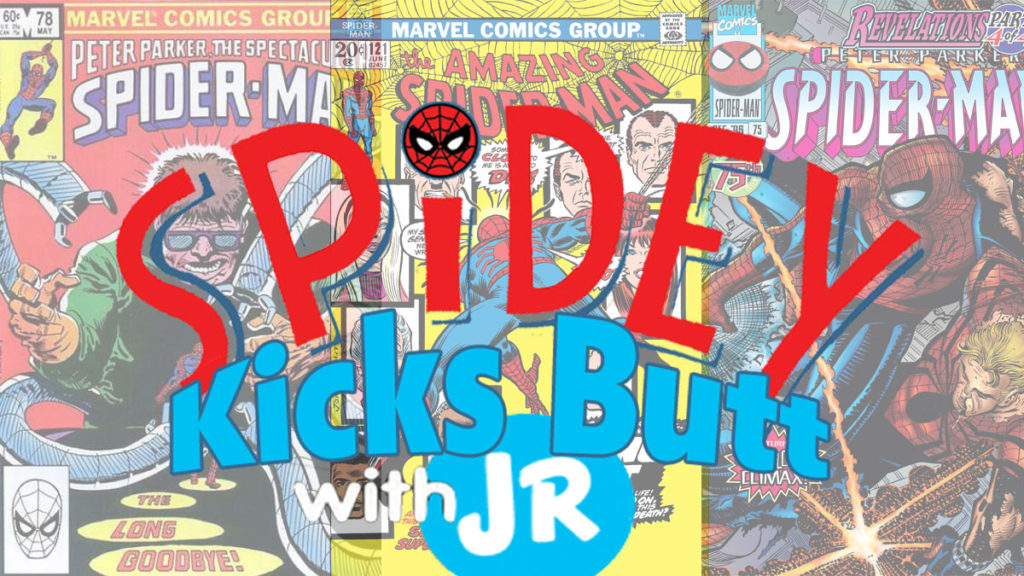
The post Spidey Kicks Butt: JR’s Top 10 Spider-Man Stories appeared first on Spider Man Crawlspace.
from Spider Man Crawlspace https://ift.tt/2VP2yEO
https://ift.tt/2BDLVFn
Sunday, 7 June 2020
Arachnid Analysis: Inferior Octopus/Superior Goblin Part 3.2: Shattering Spidey
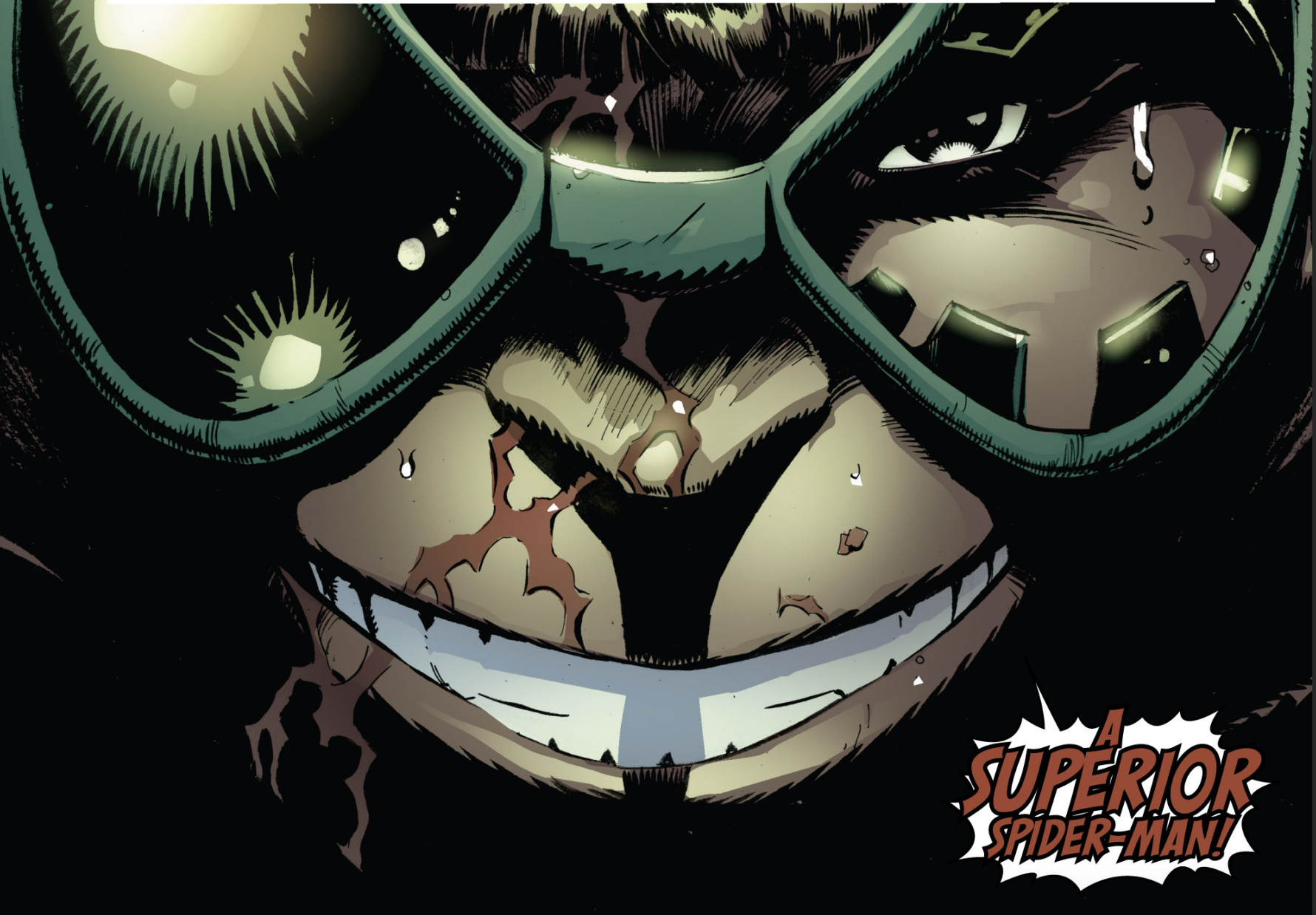
In this instalment we continue to examine Otto’s alleged victory over Peter in Superior Spider-Man #9.
Last time I discussed Peter’s alleged guilt over endangering Amy Chen’s life. My case was that it was entirely contrived and out of character.
Defenders of Superior #9 though might argue that Peter didn’t lose simply because of Amy. He lost because Ock erased the memories of his loved ones (which would surely damage his morale) and because Ock made him feel guilty about failing to stop the Vulture and Massacre.
Let’s go in reverse order and start with Vulture and Massacre.
Whilst Peter might feel guilty over the victims of these villains, Otto’s accusations could never critically undermine Peter the way the story implies they did. As with Amy, Superior #9 implies Peter had no defence against Otto’s accusations and by extension he conceded Otto’s points.
This however collapses upon inspection of Peter’s history. Peter is no fool, he is fully aware that his enemies might someday escape and harm more people. He’s known that since very early in his career and yet has never changed his ways. He didn’t even kill Norman Osborn after Gwen died, although he came incredibly close.
The Vulture (not exactly intentionally) killed Nathan Lebunsky, Aunt May’s fiancé and yet Peter didn’t even consider ending the Vulture for the sake of future victims.
‘Maximum Carnage’ arguably revolved around Peter’s temptation to kill Carnage (a far worse serial killer than Massacre) in order to save other people. Although at one point he agreed Carnage needed to die for the greater good he ultimately refrained.
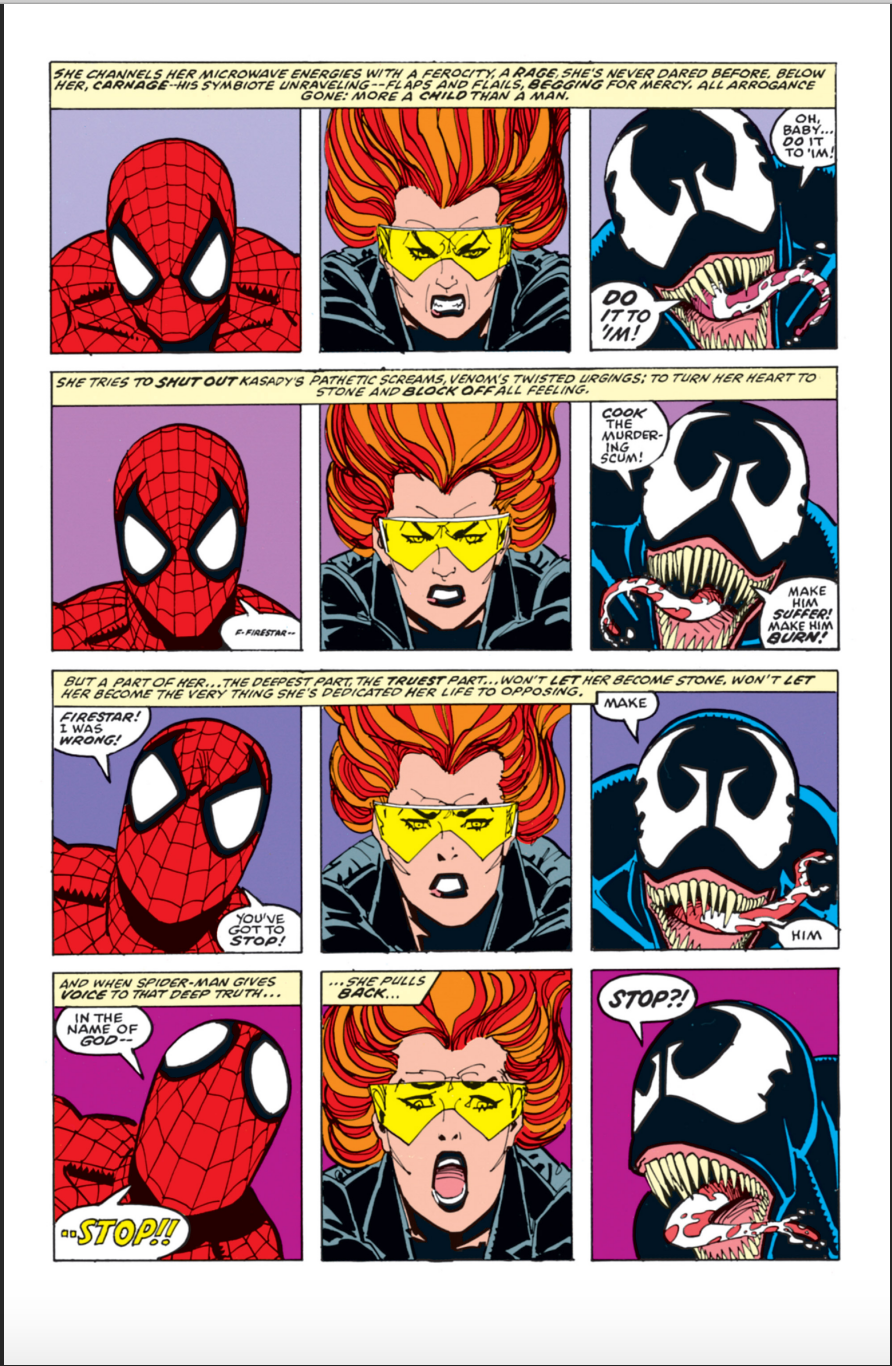
The story concluded with Spider-Man affirming his stance against killing people like Carnage.


In ASM #383-385 Spidey is blamed for all the victims of Venom and Carnage due to his bringing the Venom symbiote to Earth. Under the influence of drugs he initially concedes to these accusations, but realizes the truth once the drugs wear off.

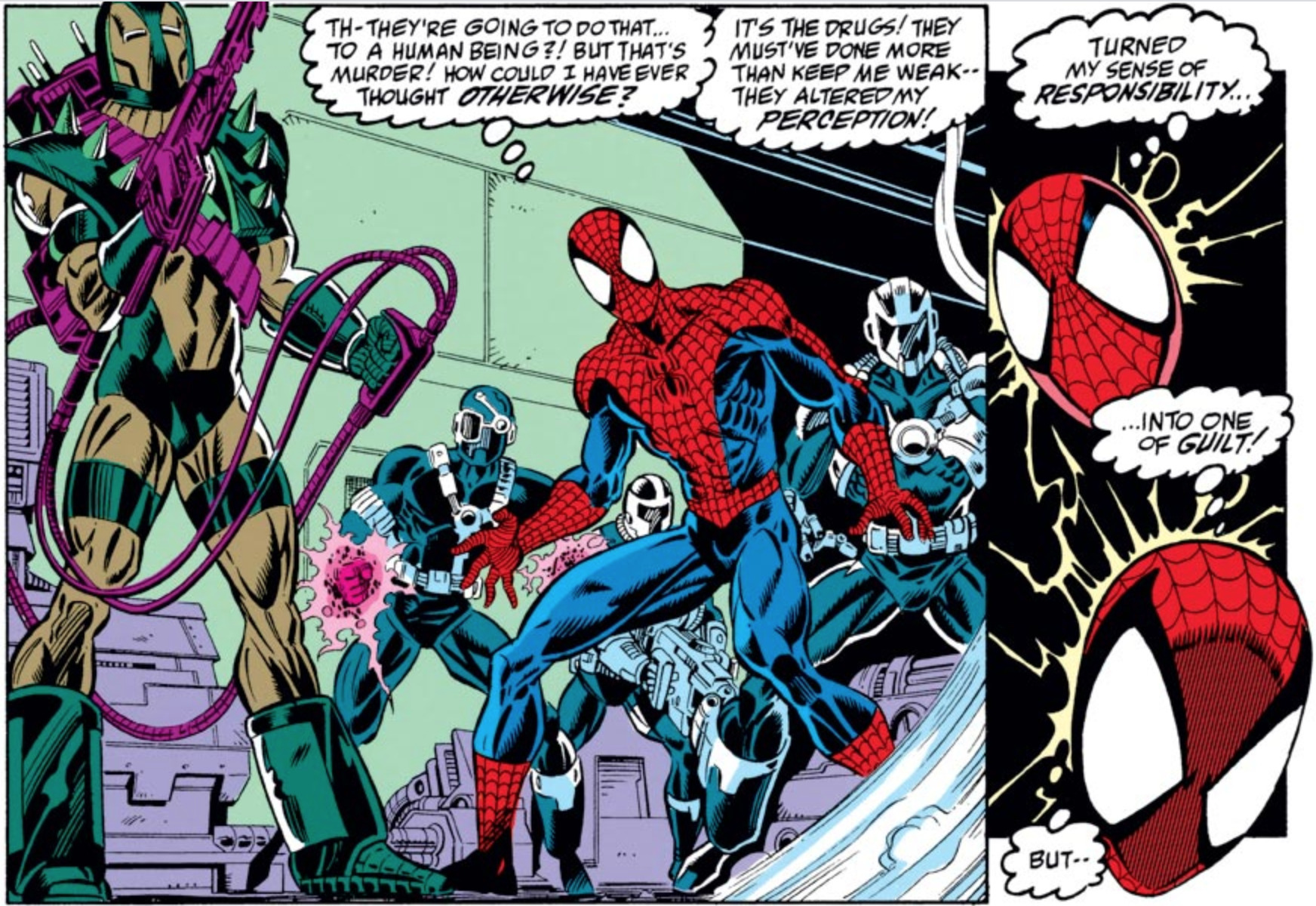
Additionally, Peter has refuted the more violent methods of anti-heroes such as Wolverine, the Punisher and Venom. Peter’s opposition to Venom’s violent ways is particularly important. This is because Venom is not dissimilar to Otto as the Superior Spider-Man. Both were ‘reforming’ foes of Peter’s possessing similar powers and operated as ‘dark reflections’ of him.
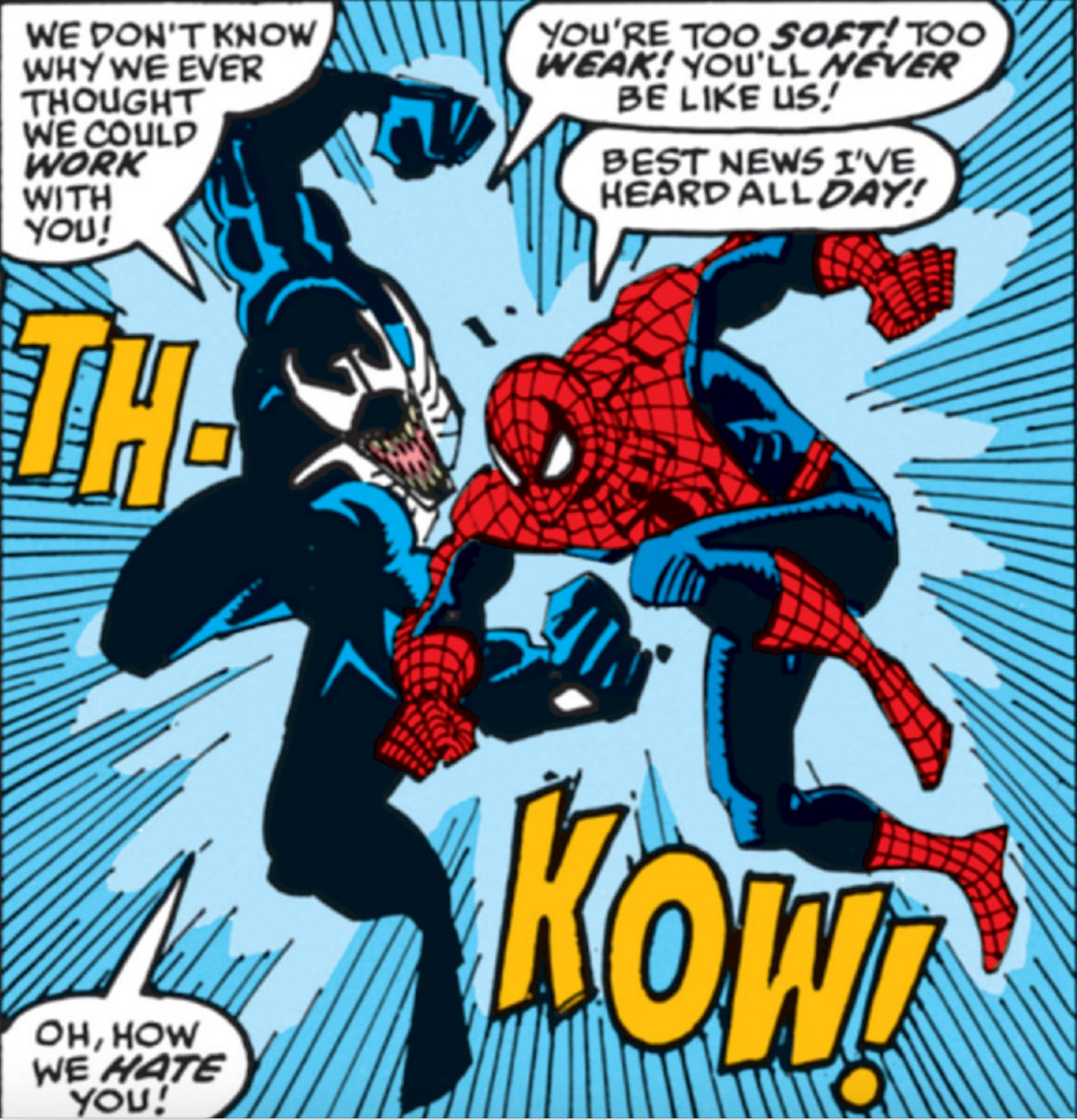
If Venom’s willingness to kill is morally invalid in Peter’s eyes there is no reason he’d regard Otto’s arguments as legitimate. *
I’m not trying to open up a debate about whether Otto or Peter’s philosophy is the right one. My point is, regardless of what your philosophy might be, we know what Peter’s philosophy is.
It had been thoroughly documented across 50+ years of history circa Superior #9’s release. And according to that philosophy Peter would never have been humbled by Otto’s accusations. Peter believes in reform and regards excessive force/murder for the greater good fundamentally indefencible.
So Otto’s accusations shouldn’t have demoralized him.
This then brings us to Otto’s erasure of Peter’s positive memories; the ones connected to his loved ones.
Couldn’t it be argued that Otto’s above accusations defeated Peter because he’d already had his heart ripped out mere moments earlier?
Absolutely not.
If you notice, Peter actually had the upper hand in their duel after Otto had erased his ‘loved ones’.
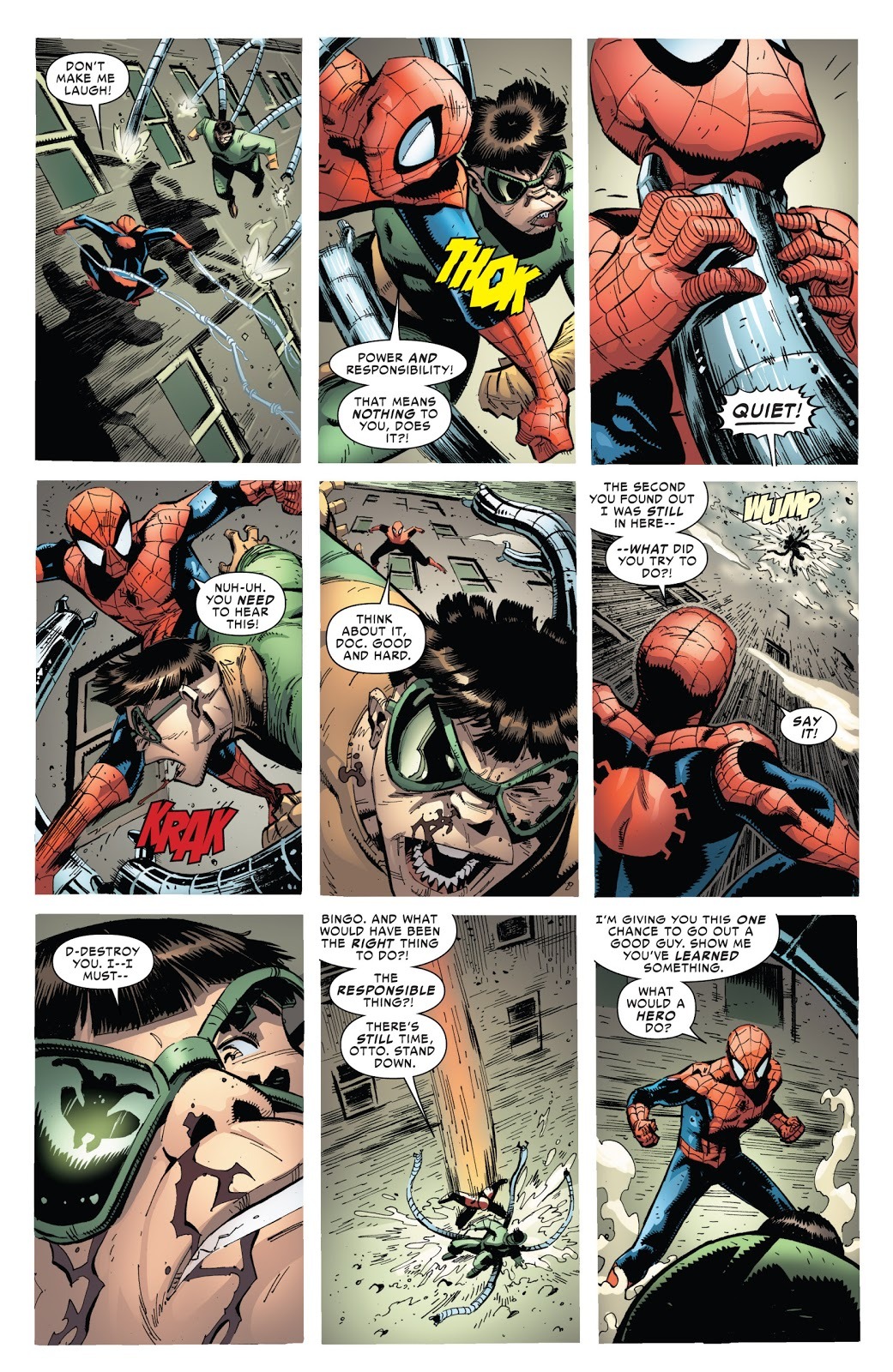
Much more importantly though Peter’s positive memories/loved ones would never have lost to his negative memories/enemies in the first place.**
Otto stated that Peter’s enemies represent all his:
- Fears
- Anxieties
- Doubts
- Failure
- Dread
- And Panic
For sure, any one of these feelings can demoralize someone, draining them of their strength. In the face of these emotions many individuals have given up on life, becoming shells of themselves or at worst monsters.***
Peter Parker however is categorically not one of these individuals.
In 616 continuity, Peter’s loved ones have been proven to be linked to this inner strength and indomitable will. Superior #9 acknowledges this reality and yet presents Peter’s above negative emotions as ultimately more powerful. However, Spider-Man canon has consistently demonstrated the exact opposite.
In Peter Parker: Spider-Man v2 #25 (the climax to the ‘Revenge of the Green Goblin’ arc, published in 2000) Peter had been drugged, imprisoned and physically/mentally tortured by Norman Osborn for at least several days. Norman had struck at a time when Peter was deeply saddened by the apparent death of his wife Mary Jane. His endgame was to corrupt Peter into accepting him as his father and in turn becoming Norman’s heir.
Eventually he got Peter to the point where he was moments away from willingly ingesting the Goblin formula. However, thoughts of Aunt May gave Peter the inner resolve to ultimately reject Norman and ‘the darkside’.
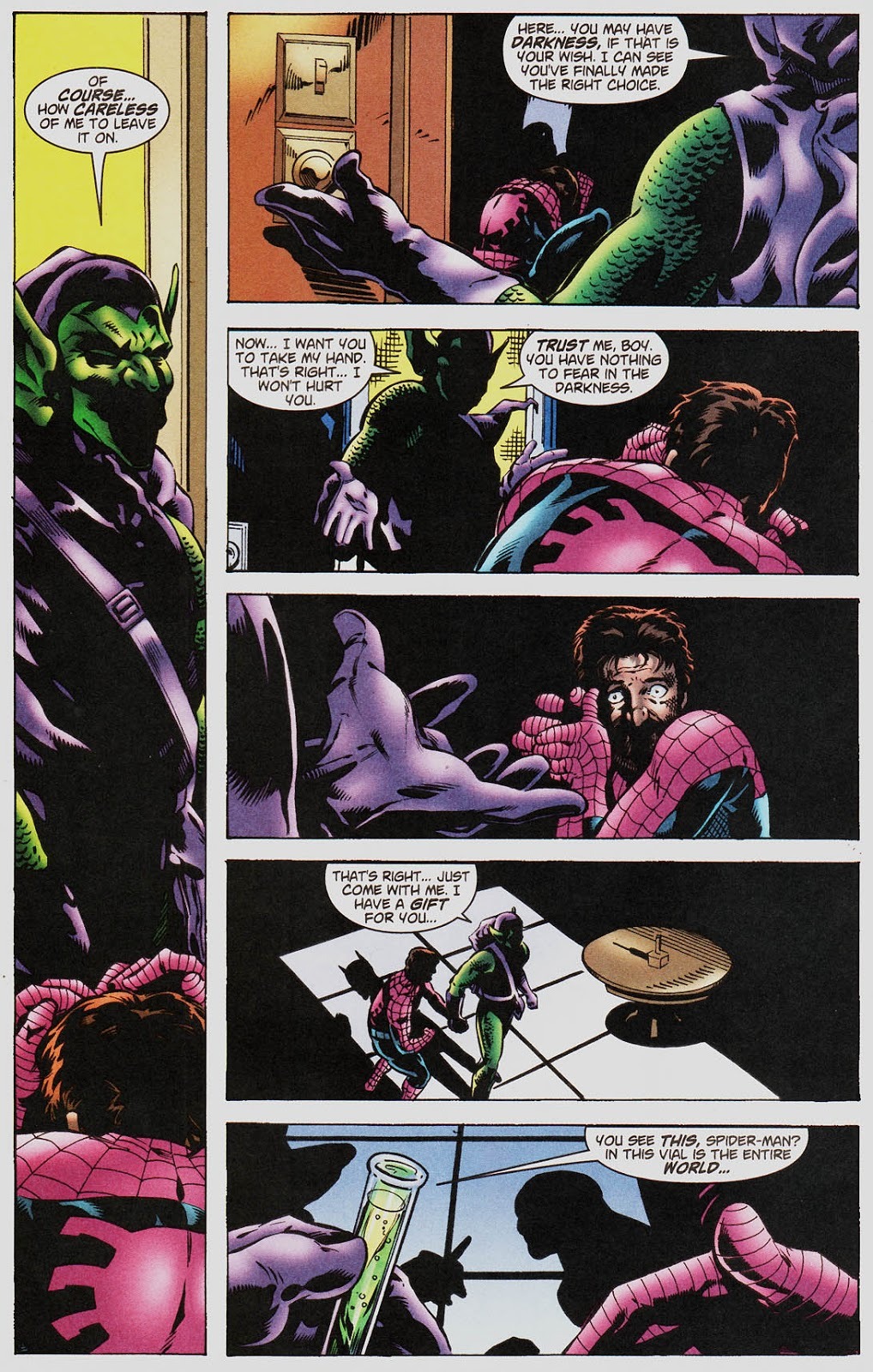
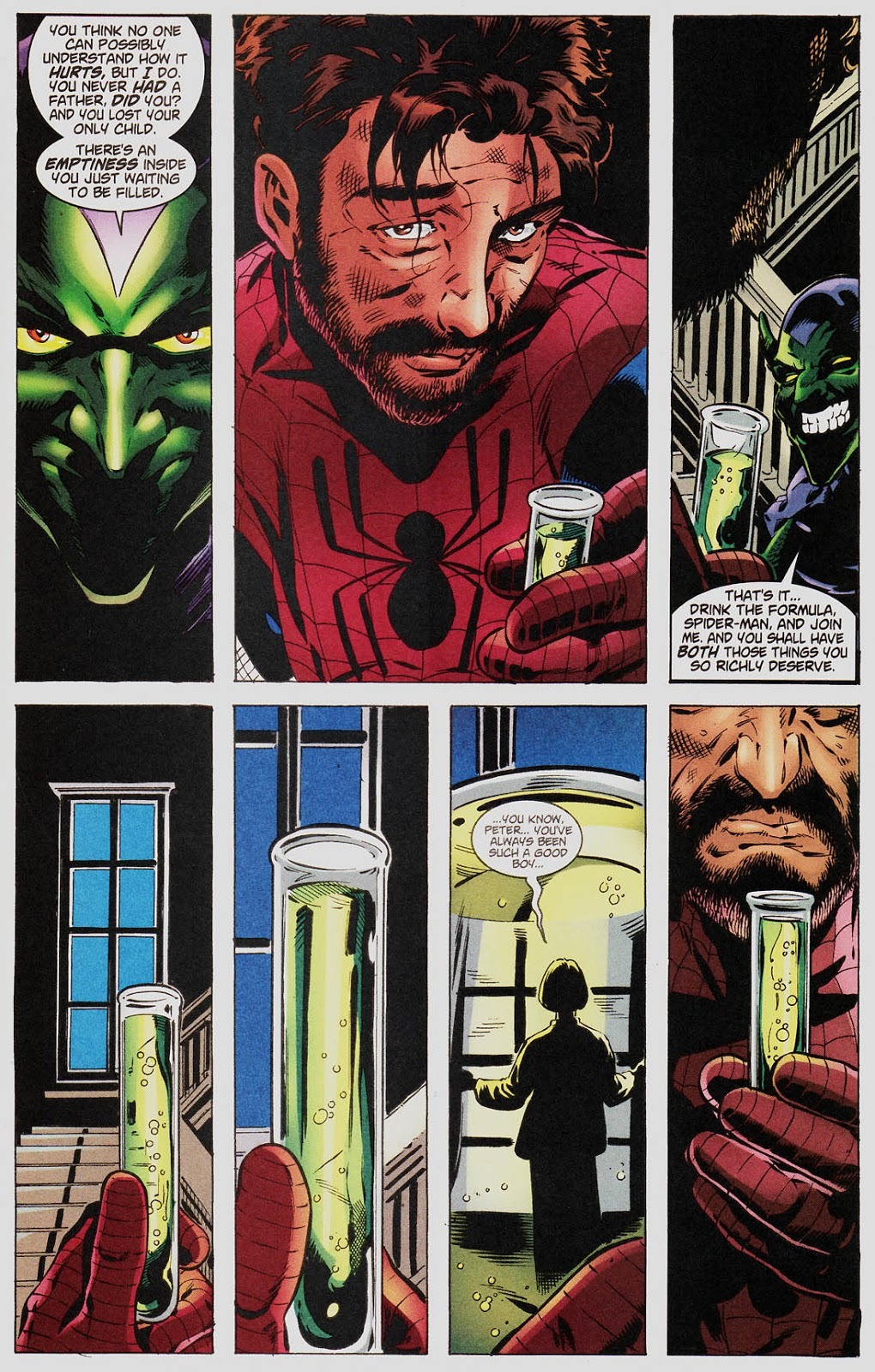

In the seminal 1987 story, ‘Kraven’s Last Hunt’ (specifically Web of Spider-Man v1 #32), Peter had been placed into a death-induced state by Kraven the Hunter and buried alive. He was sorely tempted to remain in peaceful oblivion but his love for his new roommate wife MJ drove him to dig out of his own grave.
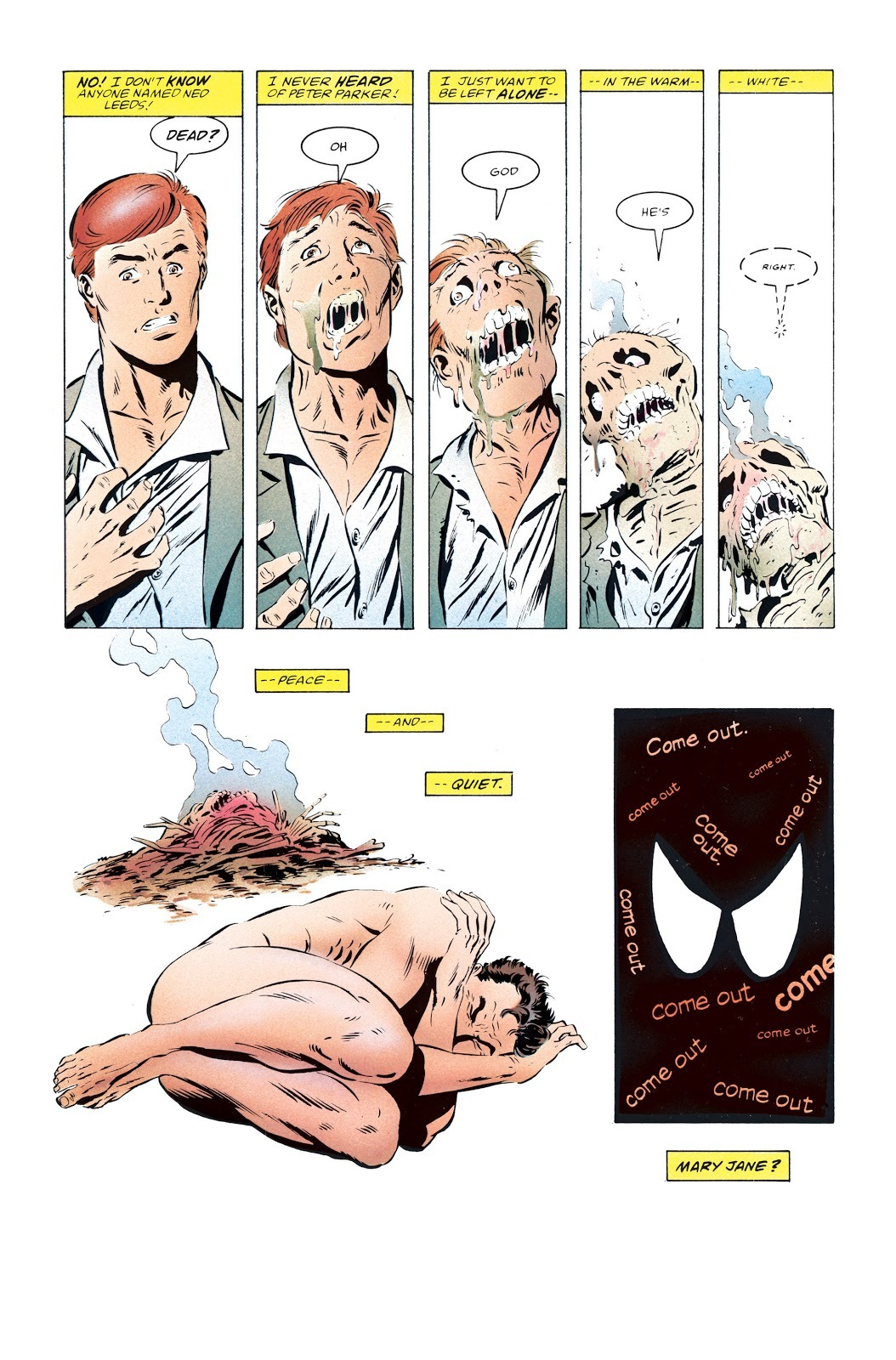


In 1975, the milestone 150th issue of Amazing Spider-Man involved Peter riddled by doubt. This was due to being uncertain if he was a clone or not. When a Spider Slayer overwhelmed him Peter initially began to give up, unprepared to live life as a fake. As life began to dwindle though his mind drifted to Mary Jane, whom he’d recently fallen in love with. This prompted Peter to realize he couldn’t be the clone and crush his doubt, going on to save himself and defeat Smythe.

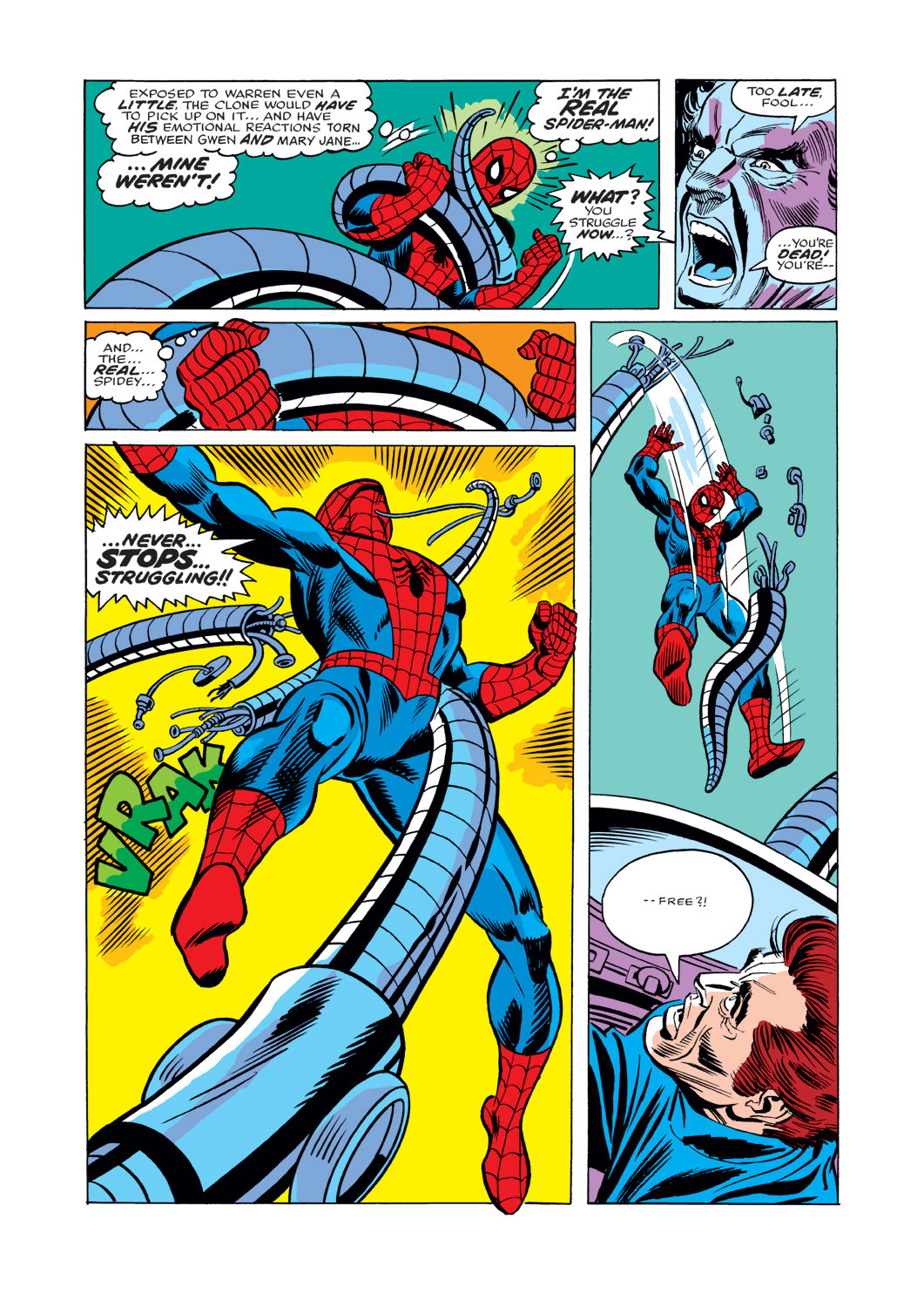
Finally in ASM #33, perhaps the most iconic Spider-Man issue of all time (let alone of 1966), Peter was buried under cast iron wreckage that outweighed a locomotive. This followed several mentally and physically exhausting events, which included battling his way through the criminal underworld, Doc Ock’s small army of henchmen and Octavius himself. It was all in an effort to save his Aunt May who was dying due to a blood transfusion he’d given her some time earlier. Octavius had stolen a potential cure that was agonizingly just out of reach of Peter as the issue began. Trapped and with May’s time drawing short, Spidey was wracked with guilt and feelings of failure in the face of his impossible situation.
But his love for his aunt, coupled with his desire to succeed where he’d failed with his Uncle Ben, gave Peter the strength to do the impossible, freeing himself.

 As we can see, ultimately Spider-Man cannot be beaten by doubt, fear, failure, etc.
As we can see, ultimately Spider-Man cannot be beaten by doubt, fear, failure, etc.
This is such a universally grasped fact about the character you need not be a comic book reader to know about it. A great example can be found in a trailer for ‘Marvel’s Spider-Man’, the 2018 video game.
Perhaps most damning of all, Dan Slott himself wrote Peter in line with this concept in his penultimate issue of Amazing Spider-Man, the milestone ASM #800.
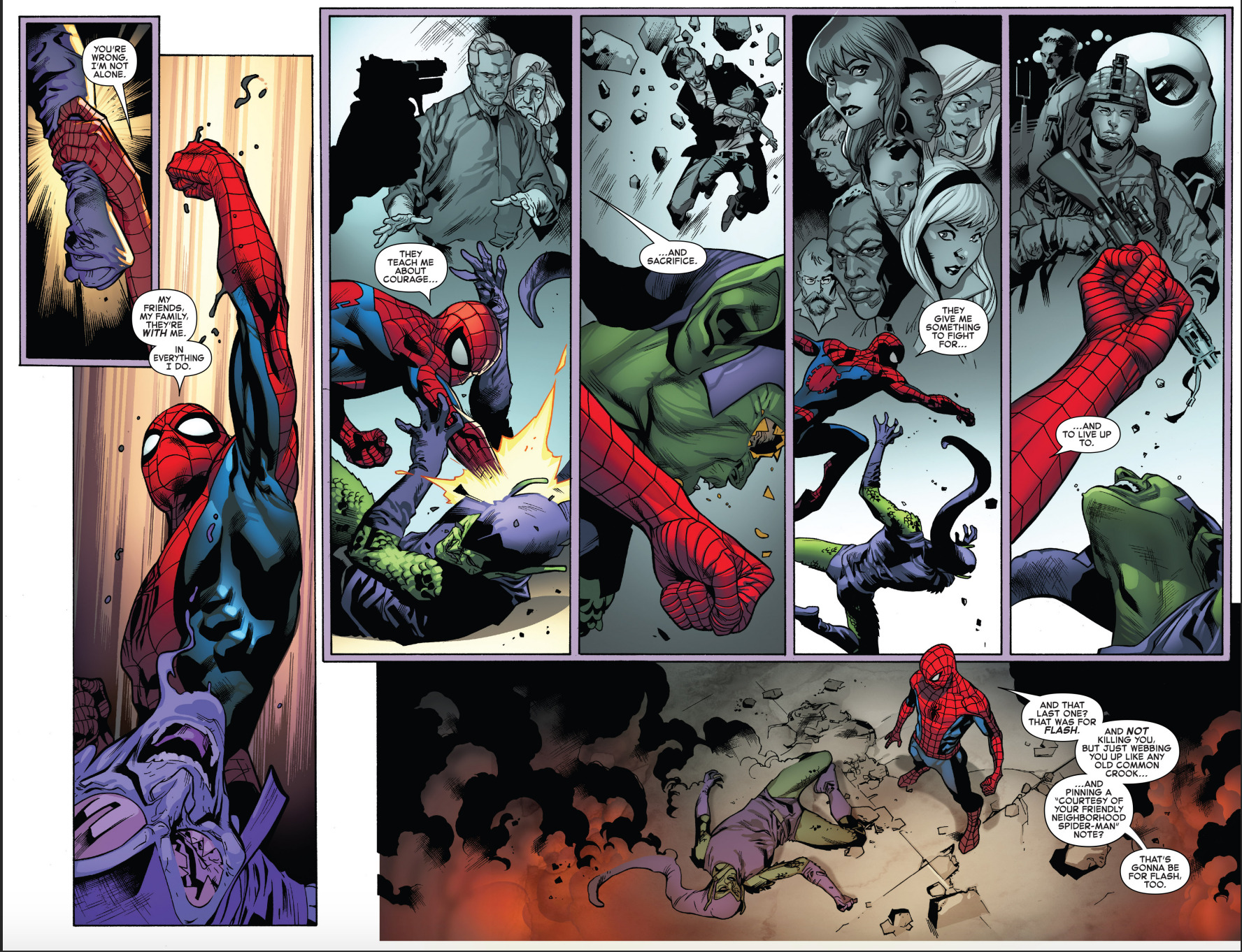
This proves Superior #9 was written disingenuously. Slott was fully aware of how a battle between Peter’s negativity and loved ones should have believably played out. But he ignored that because it didn’t serve the story and direction he wanted.
So whilst Otto’s victory over Peter in Superior #9 might seem impressive on paper, like so much of Superior, it was ultimately reliant upon aggressive mischaracterization.
Therefore it cannot be legitimately regarded in any debates involving the character. Neither those about Otto’s superiority over Peter as a Spider-Man, nor those comparing him to Norman as a Spidey foe.
*Especially since Otto is attacking Peter by citing Massacre whilst Peter has disagreed with Venom over killing Carnage.
Carnage is immeasurably worse than Massacre and Venom/Eddie Brock, for all their crimes, never tried to be worse than Hitler/Genghis Khan/Pol Pot combined (see part 3.1).
**I should also mention that it’s rather a huge stretch that Otto can summon those negative memories in the first place. They are in Peter’s mindscape and Otto is only able to erase Peter’s memories with an external device. How exactly can Otto summon, shape and command Peter’s doubts and insecurities? The whole point is that everything around them is Peter.
***Indeed, many of Peter’s enemies are testaments to this fact.
from Spider Man Crawlspace https://ift.tt/2Ui3Ffp
https://ift.tt/3haZGvl
Panel of the Day #841 (Splash Page Sunday!)
This one’s got it all!
Amazing Spider-Man Annual (Vol. 1) #1
Published: c. 1964?
Cover Date: 1964
“The Sinister Six!”
Writer: Stan Lee
Artist: Steve Ditko
Inker: Steve Ditko
Letterer: Sam Rosen
from Spider Man Crawlspace https://ift.tt/3f47rBl
https://ift.tt/2MBUiD4
Spidey Kicks Butt: Spider-Man 2002: Movin’ on Up!
Well boys and girls, it’s time once again for my annual ranting and raving about the year gone by in the world of Spider-Man, and I’m proud to say that I’ve neither gotten any smarter or any less biased than when I started this exercise back in 1999. After all, I’ve still deluded myself into believing that someone out there actually cares what I think – but since I gave up both cigarettes and alcohol during the course of the last few years and can’t stand watching Major League Baseball anymore – I’ve got to have some addiction – and right now indulging in the self-importance of my opinions about Spider-Man will do just fine.
Naturally, we all have our differences of opinion on the quality and merit of individual writers and stories, but I believe that Spidey fans will be in universal agreement that 2002 was probably the best year overall relative to the quality of the Spider-Man comics issued during the year, post reboot. I’d give this year a solid “B” on the Goblin Grading Scale. Sure, there were some stinkers here and there, but I don’t think the worst of this year is as bad as the worst of previous years, and unlike years past, I don’t think we consistently had bad issue following bad issue. However, I’m not happy with the art trends. I do not care for the “manganization” of some of the spider titles. I’m admittedly an artistic dullard, but I want bread and butter superhero art where the people look like people, not Pokemon characters.
As far as what comics are covered during this review, most of the Spider-Man comics issued during 2002 were fair game. For the first time during the initial writing of a “Year in Review” column, I have included references to Ultimate Spider-Man and Spider-Girl. However, for sanity’s sake, I have not referenced any of Spider-Man’s guest appearances in other character’s magazines, nor did I cover that manga Spider-Clan bastardization.
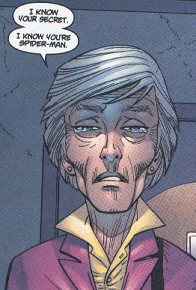
Aunt May Knows!
Without a doubt, this was the single most important spider-tale of 2002. In fact, it’s probably one of the most important spider tales – what, ever-? In Amazing Spider-Man #38, dear old Aunty May drops the bomb on Peter that we have been expecting since she found him bloodied and bruised and his tattered costume on the floor at the end of issue #35. This is the only reason justifying May’s return from the grave, where she was originally committed back in the classic Amazing Spider-Man #400. I’m still not convinced that bringing her back was a good idea, particularly since that issue was a genuine tear-jerker and put probably the best final punctuation mark on May and Peter’s relationship – but give JMS credit – he clearly realized that if May was going to be a significant continuing character, there was going to have to be some meaningful evolution in her relationship with her favorite nephew – a relationship that seemed to have actually regressed when the Mackie/Byrne/Harras trio resurrected her (o.k. – I forgot, they did give her a new hair style. Wouldn’t want to not give them credit for that.)
But then there’s the little question of just why JMS tinkered with the details of the night that Uncle Ben died. In this version, in order to assuage Peter’s guilt over the events of that night, May tells him that she was also at fault (??!!!?!?) because she jumped all over Ben’s case that night over something stupid so much so that he took a walk outside to chill out – and she never saw him alive again. What does this mean – that he was the victim of a drive-by – or that he didn’t come back into the house until May was asleep – and surprised the Burglar then? No less an authority than Amazing Spider-Man #200 (January 1979)which essentially re-told the Amazing Fantasy #15 scene, this time from May’s perspective, clearly had Ben being shot dead there in the house, right in front of May, with Ben subsequently dying in her arms.
The point of mentioning this is not to trot the continuity police out against JMS on an event which has had various different spins put on it by different authors over the last 40 years – but in using ASM #200 as our reference – having Ben shot dead in front of May underscores just what a brutal act of violence this was, and how it traumatized May, and how Peter’s guilt over the incident is magnified because of the horror that May experienced, not just that Ben died as a result of his inaction. To have Ben wander off and die like a old, sick dog undercuts this event, which is why I don’t care for this interpretation. Also, how hard would it have been to have read that particular issue? Later, I’ll hold JMS harmless on an event that occurred in a Marvel Team-Up annual, but ASM #200 – not only has every hundredth issue been designated as something of a landmark issue – it’s also near the top of all-time Spider-Man stories (o.k., in my opinion) since this is where Spidey settles his oldest score. That glitch aside, though, kudos again to JMS for forcing Marvel to accept an event that is long overdue from a dramatic standpoint. It probably wouldn’t have happened under the Bob Harras regime, nor would there have been very many writers with sufficient clout to convice Marvel that something of this magnitude needed to happen.
Paul Jenkins had his own spin on “May knows” in Peter Parker #50, which revolves around another meeting between Peter and May where the implications of her recent discovery are discussed. And to the sheer delight of older fans, May has to fess up to (1) trying to shoot Spider-Man in ASM #115, and (2) in one of the all-time spider clinkers, nearly marrying Doc Ock, in issues #130-131. Of course, May doesn’t really explain her rationale for these examples of bizarre behavior – but there probably isn’t any way to redeem them, no matter how talented the writer – so they are best left referenced, and then ignored.
In one of those things that shows the strength of having two different writers handling a character at the same time, both Jenkins and JMS present diverse, yet compatible takes on May’s discovery. JMS gives us May when she first finds out, and she is reeling not only from the knowledge itself, but the reality that she doesn’t know her nephew, the person she loves more than anything or anyone else, nearly as well as she thought she did. She also has to reconcile the fact that he has repeatedly lied to her and shut her out of an important part of his life for 15 years(thanks to Brian Bendis in a recent issue of Alias – the Marvel timeline has been given a recent, and realistic frame of reference).
Jenkins’ version has May no less concerned, but dealing with the revelation with a little more humor and spunk, as when she creates a diversion in a park so Peter can rescue a cat from a tree (much to his aggravation). Still, even then, May begins to understand the ramifications of just how much of her life is truly out of her control when Peter confesses to her that Norman Osborn is the Green Goblin, knows who he is, and that he is quite capable of using May to get to Peter. (There’s some continuity glitches here, though, as Peter talks about Norman Osborn “giving” Harry the Goblin formula – which we know didn’t quite happen that way – but this isn’t the article to hash that out).
JMS Round 2
JMS definitely had a better second year than his first with the title. After the “Aunt May knows” story, unlike Howard Mackie, who gave Peter a high-tech sci-fi job with much fan fare, and then forgot about it, JMS remembered that Peter is now a teacher at his old high school, and wove that as the primary driver of a plot in which Spider-Man investigates the disappearance of homeless kids from the mean streets. While it brought Spidey into the world of magic, where he really doesn’t belong, it wasn’t too bad (as long as it’s not a recurring theme) and introduced another potential supporting character in a Lt. Lamont, who isn’t enamored of superheroes, but tolerates them. While I don’t know how this is ultimately going to work out, dealing with the concerns faced by his students and interacting with a member of the police force does give Spidey an anchor in the “real world” in contrast to simply bashing colorful supervillains twice a month.
Doc Ock pulls double duty in 2002 (not counting his cameo at the beginning of the mini-series Quality of Life) in both Amazing Spider-Man and Peter Parker, as JMS has him pursuing a corporate yuppie who has stolen and modified his mechanical arms. This pursuit takes Ock to Hollywood, where suprise, surprise, Peter and May are visiting Mary Jane (as JMS begins to weave her back into the storyline – again more kudos to JMS – but since this doesn’t pay off until the following calendar year – I won’t touch on it now). His characterization of Doctor Octopus and Aunt May as people who know each other (without referencing all of the details) settled down some of us continuity folks who have rightly wondered if JMS has done his homework when it comes to Spidey’s history.
Of course, the continuity police cited a violation when Dr. Strange stated that he didn’t know Spider-Man’s real name when fans of Marvel Team-Up Annual #5 remember Strange calling Spider-Man “Peter,” and in another story (the issue number escapes me, but I believe it was a trade) Strange tells Spider-Man to “go home to his wife.” I’ll cut JMS some slack on this one – I do think he should have read ASM #200, but I hold him blameless for not reading Marvel Team-Up Annual #5. Hell, I didn’t read MTU Annual #5 until years after its release when I began filling my back issue holes. Actually, I prefer to think that JMS’ characterization of Strange was more on target than in MTU. Dr. Strange probably could know everything about everyone if he wanted to, just as Matt Murdock with his radar sense and Professor X with his mental powers could pierce through any secret identity. Strange has probably over time had to develop the means of being able to shut out information (much like as once referenced in a Classic Star Trek episode, a telepath has to learn not how to read minds – but how NOT to read them) not only to keep himself sane and from being completely overwhelmed with information, but also he likely desires to respect the privacy of his compatriats and therefore chooses not to know everything about them unless it is absolutely essential.
But, alas, it appears that the mystic spider crap is still alive and well, as we get Ezekial the mumbling, talking in circles, old wall-crawling dude showing up again after Spidey faces yet another creature from beyond that wants to eat him – this time the black as coal super wasp called Shathra. The Shathra story wasn’t all that bad – one reason being that it was a more reasonable length than the similar Morlun story, which ran six months, including two issues (#33 and #34) which were virtually identical. Still, we essentially got a retread of the Morlun story – a seemingly unstoppable foe that’s drawn to his spider-totem, spider-smell, or whatever.
And, of course, I couldn’t forget to mention Mary Jane’s return to the stories on a recurring basis. It was good to see her back, and her exchanges with Peter indicates that their eventual reconciliation (which didn’t happen until 2003) is going to be a challenging one at best – hopefully which will put the lie to Marvel’s persistent belief that there can’t be dramatic tension in a married couple’s relationship. But that’s a subject for the 2003 annual rant.
Paul keeps plugging along
Almost as if in response to JMS’ statement that he didn’t want to use Spidey’s rogues gallery (the Dock Ock story notwithstanding), Jenkins decided to give us BOTH of Spidey’s greatest villains in back to back storylines (interrupted by Zeb Wells’ MTV Beach Party story). The first up is Doctor Octopus (Peter Parker #39-41), who seems to be cowering in fear of Jenkins’ own creation, Fusion II, making an early return. But the Doc is just biding his time, as he eventually exacts a vicious toll on whoever stands in the way of his ultimate objective. His treatment of Fusion is particularly ghastly as Jenkins reminds us of just how much of a psychopath the good doctor really is – although his motivations (diamond theft for profit) are a little, well, mundane in this story.
Of course, that brings to mind the modest disparity in the way Ock is portrayed by JMS and Jenkins in their respective stories. JMS portrays him as a brilliant, yet twisted genuius who hates Spider-Man and most of humanity, but still has a shred of decency, as when he comes to May’s rescue against “Carlyle Calimari” (as Spidey referred to the fake Ock), and helps innocent bystanders to flee a collapsing hotel. He also craves to have his work achieve legitimacy in the scientific and business community. The Jenkins Ock, on the other hand, seems to have no such decency and is purely twisted and mercenary. This really isn’t surprising as Doctor Octopus has been written with little consistency since his arrival on the scene waaaay back in volume 1 of Amazing Spider-Man #3 and I really cannot find any fault with either of his portrayals in 2002.
After the Doc Ock story, Paul really clicks with the return of Norman Osborn in “Death in the Family.” But I’m going to discuss that later.
The return of Fusion II brings to mind Jenkins’ other major story of the year, in Peter Parker #48-49 which deals with the coverup of a biological experiment in India. It gives us our third original Jenkins villain in the Virus, which at this point seems to be little more than a Venom knock-off – same color, same ability to ooze in and out of places. At least he was no Typeface – but it makes me wonder if it is possible to create any new, strong villains that aren’t either a knock off of an established concept or just plain lame.
Nuff Said Not Bad
Everyone who has read my articles knows how I thoroughly despise Marvel’s gimmicks and crossovers, so when I heard of “Nuff Said” month, where the stories were going to be told strictly without dialogue, I was aghast. However, where Spider-Man was concerned, both JMS and Jenkins pulled it off, and pulled it off quite well. JMS was actually able to advance his storylines, such as Aunt May’s newfound knowledge, and Peter and MJ’s separation beginning to weigh heavily upon both of them, and Jenkins told a completely off-beat story which featured, quite appropriately, a group of evil mimes (with the visual treat of Spidey mooning the mimes, goading them to follow him into his trap).
Believe it or not, I actually enjoy eating crow every now and then, at least when it’s because of a better than anticipated quality product, which benefits all spider fans.
Attack of the Zimmer-Man
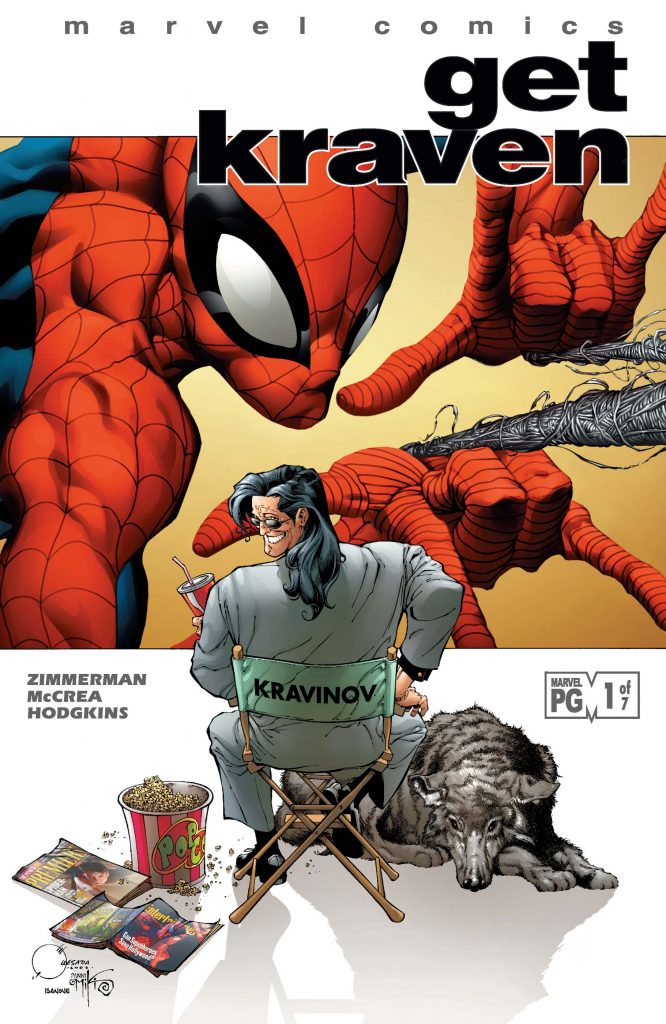
Without a doubt, one of the most controversial and talked about elements in the spider-universe was Joe Quesada’s bringing in former Howard Stern crony/writer and Hollywood denizen Ron Zimmerman into the fold. In one of those strange double standards, it seemed that Zimmerman was savagely attacked by fandom before he wrote one word because he didn’t have a “comic” background – even though what Marvel has desperately needed for some time was an injection of new talent and perspective, rather than relying exclusively on the same old tired stable that had long ago run out of viable ideas. This won’t win me any votes in the fan community, but I do believe that some of it, (not all, of course) was provoked by the jealousy of those who either want to become professional comic creators, or know those who are trying, and for whatever reason (cronyism unfortunately being one of those sad facts of life in corporate America) can’t seem to get the break they deserve. And to these fans, the Zimmerman hiring seemed like just that. And, they may not have been that far off base.
Unfortunately, Zimmerman, who was used to bare knuckle brawling after having to deal with the Stern staff and in Hollywood (experiences that would jade anyone), came out swinging and made two very public and very unfortunate mistakes. First, he dissed the quality of writing of the spider titles (which was actually deserved where ASM was concerned at that time), but he captured writer Paul Jenkins in that tirade. It was bad enough that Jenkins was a fan favorite at the time, who had already ratcheted up the quality of Peter Parker, but what compounded the error was that Zimmerman was forced to admit that he had never even read any of Jenkins’ writings. To Zimmerman’s credit, he publicly fessed up to this mistake and apologized to Jenkins.
However, his profanity laced tirade on the Spider-Man Message Board probably permanently damaged his relationship with many spider-fans. In addition to the viciousness of his rant, he also asked the same question that inevitably almost any professional asks “well, how many of you are professional writers?” The SMB was the wrong place to ask that question at that time, as one of the moderators then, “Cap,” otherwise known as John Vornholt, IS a prolific professional writer with several publishing credits in different fields, sci-fi and children’s literature among two. Vornholt cut Zimmerman no slack and had him banned from the board.
Ooops.
But in looking at the stories themselves, distancing ourselves from all of the surrounding nonsense, they are a mixed bag.
Zimmerman’s first effort, the Spidey-Jay Leno “team-up” which ran in three parts as a back-up story, is dumb, but harmless, and probably wasn’t a bad idea at the time – trying to get Spidey some more mainstream exposure to coincide with the release of the first film. After all, no one, and I mean NO ONE, anticipated that the film would be such a huge juggernaut, even out of the starting gate. I enjoyed Leno’s rips on the X-Men, particularly why Wolverine scares people (it’s not that he’s a mutant, it’s that he’s got sharp claws and a bad attitude and likes to cut people up). The story is short and isn’t worth the venom some fans have hoisted on it.
And frankly, I thought Tangled Web #13 was terrific – it made me lift my self-imposed ban on reading that title. A mysterious villain (ultimately revealed to be Norman Osborn – now you know why I picked up the book) strolls into the Bar with no Name and engages in conversations with “Al” Kraven and the Vulture about everything from Spider-Man to women. Although the character soon grated big time later – I even liked the portrayal of “Al” Kraven here. Look, there was the original Kraven (never a fave of mine), and we all know what he was, a Most Dangerous Game knock-off. You know, I am the hunter and you are the prey and I can smell you a mile away, blah blah blah. After he blew his brains out at the end of Kraven’s Last Hunt we got Vladimir, the first son of Kraven, a Clone Saga era misstep who was another one of those “hunt the Spider” bores. Then we got a second son of Kraven in Aloysha (yes, that’s “Al”) and while JM DeMatteis gave him a different take, he was still a jungle man. When Howard Mackie brought back the Sinister Six in a 1999 fiasco, he simply made “Al” a Kraven I clone. But Zimmerman takes the character in a unique direction, making him the arrogant, spoiled, yet still somewhat principled, scion of a wealthy man who has to reconcile two major conflicting emotions about his father – a love for the man who bequeathed him his wealth, his physical prowess, and his respect for nature, and a loathing for the man who was also a self-indulgent criminal who often didn’t practice what he preached.
The story has a lot of flaws – for example, I can’t believe for one minute that Norman Osborn would telegraph that he was the Green Goblin to anyone – let alone a bunch of costumed losers in a bar (this was a couple of years before his outing in The Pulse in 2004). And how did the Vulture know that Osborn was the Green Goblin prior to the beginning of the tale? Hadn’t Norman been able to successfully break the public speculation that he had been the original Goblin? But, these glitches aside, I was highly entertained. The stunned expressions on all of the villains’ faces when Osborn reveals himself in the midst of telling the story to end all stories on what he did to Spider-Man (killing his girlfriend in front of him), and leaves behind a pumpkin bomb, was worth the price.
And if I was entertained, that covers a multitude of sins.
“You can call me Al,” another backup tale, on the other hand, was awful, a case of telling a bad story in addition to not doing your homework. As far as just how bad it was – well, that comes later.
Sweet Charity on the other hand, represented both the best and worst of Zimmerman. I could present a long list of things I really liked about this story. And I could also present a long list of things I really didn’t like. For one, the thing is twice as long as it needed to be, and seems to have been presented to “showcase” Zimmerman. Rather than an expensive stand-alone, if it had been a one issue guest shot during one of the regular title runs, it would have worked much better. I do feel that Zimmerman actually did a good job with the relationship between Jonah and Spidey. Although he really didn’t introduce anything new to it – he humorously presented a relationship between two people who deep, deep, deep, deep down have a certain amount of mutual respect, but whose public differences and previous conflicts have created such hard feelings that they are simply unable to communicate with each other unless they are shouting at or pranking each other. Spidey’s ultimate prank on Jonah which concludes the story is a genuine hoot. But the Hollywood name-dropping, with the exception of Al Pacino’s misery at having to spend a depressing day with Wolverine and Rogue (“after awhile you just want to say “touch me, Rogue””) is at an irritating high here. And some of the humor eventually goes go way over the top, such as the Scorpion muttering in his sleep, and Spidey getting a case of the runs when he eats some wild berries.
And then of course, there’s Get Kraven, which I must say – I DID NOT READ. Why? Because for the most part, it wasn’t about Spider-Man, it was about “Al” Kraven in Hollywood, which I had no interest in reading. Spidey does make appearances on the front and back end of the story, and inexplicably the Vulture becomes a quasi good guy at the end (don’t worry spider fans – that didn’t take), but it’s not fair to trash a story I never bothered to read. I’ll let the reviews that were performed speak for themselves – as well as the fact that the story was shortened from seven parts to six.
Mini-Series Mediocrity
Marvel clearly wasn’t going to let the release of the Spider-Man movie go by without generating a lot of additional product to take full advantage of it – hence not one, not two, but three miniseries concurrently released in order to give a spider hungry public the superhero action Marvel was counting on them craving. What we got was some slick looking, but ultimately less than fully satisfying stuff – that is, whenever we actually got it – as only one of the minis stayed on its original release schedule.
Spider-Man:Blue
Boy did I want to like this series. After all, it was the team of Loeb and Sale, who brought us the acclaimed Daredevil: Yellow. And everyone in fandom was saying what a wonderful series this was, beautifully written and drawn – and, and…I didn’t like it. On another matter, I try not to bring out the badge of the continuity police if I’m entertained, but Spider-Man:Blue wasn’t good enough for me not to notice the problems. Still, it had some terrific covers, most notably issue #3 (pictured above). Yowza.
My first problem with Spider-Man:Blue was the price. I’m sorry, but $3.50 is a bit much to pay for a 22-23 page comic. And after the first couple of parts, it seemed like it was being “Bendised,” you know, that term for using a talented artist to tell a story with minimal dialogue and stretching it out at least twice as long as it has to be.
What Loeb and Sale did do, however, was re-introduce “slinky Gwen,” whom we actually hadn’t seen since – well – the exact same period of time during the Amazing run that Blue was revisiting, before she was turned into a crying Daddy’s Girl and wholesome “girl next door” type. However, with both Gwen and MJ as mouth-watering sultry types, Blue unwittingly illustrated the quandry that Stan Lee and John Romita were in when they were writing the Spider-Man mythos for the first time – you can’t have two virtually identical girls in any series for any length of time. Either one will have to go or have her personality changed. In the original run, Stan and John chose to de-sex Gwen.
I really did like the first part, and not just because it started with a big full color picture of the Green Goblin’s grinning puss. There was actually some movement in the story as we were introduced to all of the characters, and Gwen and Peter started exchanging “come hither” looks. In part two, a comment by Gwen leads Peter to discover a method to defeat the Rhino, which reminds us that Stan had originally created Gwen as an intelligent, scientifically-inclined young woman – perhaps the equal of Peter Parker.
But then, nothing much happens. We get a lot of large, pretty, colorful panels with minimal dialogue, but we really learn nothing more about Gwen than we already knew or why Peter is attracted to her other than she gives him a hard on. It appears in part 6 that she admires Peter because when everyone else runs from danger, he runs into it – but doesn’t this contradict the Gwen in the original Stan Lee/John Romita run who was worried that Peter was a craven coward, even to the point of privately sequestering Flash Thompson back in issue #78 of Amazing Spider-Man to find out what Peter’s deal was – or the Gwen in issue #108 who was crying that “whenever there was danger…you always leave and run off…Flash and the others called you a coward!” Oh yeah, we don’t care about continuity, only consistency. Speaking of which, Blue twists around the order of several events to fit into the context of this particular tale – but in doing so, it doesn’t improve upon the original re-telling, which is the only reason to take such liberties. In this version, much of the supervillain action at the time was all at the behest of ho-hum villain Kraven, whom Spidey flattens with little effort in Part 6, after a relentless build-up.
A much sweeter, much sadder, much cheaper, and much more effective version of what was trying to be accomplished was in JM DeMatteis’ backup story in Webspinners #1 entitled “The Kiss,” where Peter ruminates on his last night with Gwen before her eventual murder by the Green Goblin.
It’s obvious that the memory of Gwen Stacy fascinates writers just as it haunts Peter Parker. But it’s also just as obvious that no one has quite successfully figured her out yet. When they do, that should be a good story.
And you noticed that I avoided all references to “Sins Past.” I didn’t want to obscure my observations from years ago with the revelations from that storyline.
Spider-Man/Black Cat: The Evil That Men Do
I was actually liking this miniseries – when it was coming out. I have always liked Felicia, and think that she makes a good foil for Spider-Man. Essentially, she makes a good “bad girl,” and I would certainly not object to Felicia’s continuing presence in the core titles to add a little bit of sexual tension to Peter’s life, now that Mary Jane, formerly the “bad girl” has now settled into being the wife and the “good girl.” Some of Smith’s blatant sexual overtones turned off some people (such as Felicia’s reference to her and Peter doing “the nasty,”), but as long it is confined to this one miniseries and doesn’t become a fixture in the other spider titles, I can handle a slightly more mature tone – although I wonder how this accomplishes the oft-stated goal of getting “the kids” back into comics. And if Spider-Man is going to be on the cover – then both parents and kids are going to think it’s appropriate for the younger set – that’s the result of Spidey being a pop culture icon. Still, it was usually either Felicia or guest villainness Scorpia who were making the double entendre references, and NOT Peter or Spidey, so that made it more tolerable. However, I still can’t believe that Kevin Smith actually had Felicia get the drop on Spidey and punch him silly and web him down to a roof so she could go after the bad guy alone. I mean, really…..
Unfortunately, after part 3 of what is supposed to be either a 4 or 5 part series (I’d heard both – and then it ultimately became a 6-part series) was issued – for all intents and purposes Kevin Smith’s comic work fell off the face of the earth, and THAT became the issue, rather than the quality of the story.
Of course, I survived without ever seeing “The Night They Tore old New York Down,” that “way out thriller” that was supposed to be in issue # 2 of Giant Size Super Heroes Featuring Spider-Man way back in 1974, and “The TV Terror,” which was supposed to be the subject of issue #3 of the first Spectacular Spider-Man, the magazine that was briefly published back in the 1960’s. Of course, there never was an issue #2 or #3 of these titles, respectively, but I survived, and life went on for both me and Spider-Man. I suspect that the same will occur if we never see another issue of The Evil That Men Do.
Again, with a nod to more current times, this story was finally completed, and is reviewed in its entirety in the 2005 Year in Review.
Quality of Life
Quality of Life is a gimmick, but it’s a good gimmick as it gives us a visual style that we have never seen before in Spider-Man – a completely computer generated comic. It also had promise because the writer was Greg Rucka, whose work on Detective Comics I liked, and I was also fond of his series for Oni Press Queen and Country. However, it featured the Lizard – and wasn’t Curt Connors cured of being the Lizard by a souped up Hammerhead in last year’s Lifeline miniseries (however, there is an implication that the chemicals introduced in the area where the Connors were living re-triggered the transformation – remember, it’s not continuity – it’s consistency)? The story involved Curt Connors suing a corporation because its products caused his wife Martha, to develop cancer, which, in a major character development, kills her by story end. The firm hires a half woman half snake assassin known only as “Yith,” to take out Connors – but in the end, she almost turns into the half woman half snake assassin with a heart of gold, feeling sorry for Connors for his loss, and turning on her employer after asking him “have you ever been in love?” Awww.
The Lizard has never been one of my favorites because he has largely been a one-note character with an utterly dumb motivation – that of trying to promote the ascendancy of reptiles over mammals – and I never really liked the idea that he often had no vestigal memories of being Curt Connors (and yes, I remember that a couple of years later, Paul Jenkins turned this on its ear with the “revelation” that Connors had always been in control of the Lizard – why I don’t buy). This time, however, it seems that he does, as the Lizard turns out to be the expression of Connors’ grief and rage over the illness and ultimate loss of his wife. Even with that improvement in the character’s interpretation, all in all this is an unmemorable effort.
The Daredevil/Spider-Man one shot was just a marketing ploy to take advantage of the fact that at the time it was issued, the Spider-Man movie had been a huge success, and the Daredevil movie was upcoming for release. And the story reflected that it was all a ploy as our two heroes didn’t even meet or talk or otherwise interact with each other than a nod from a distance. So why bother?
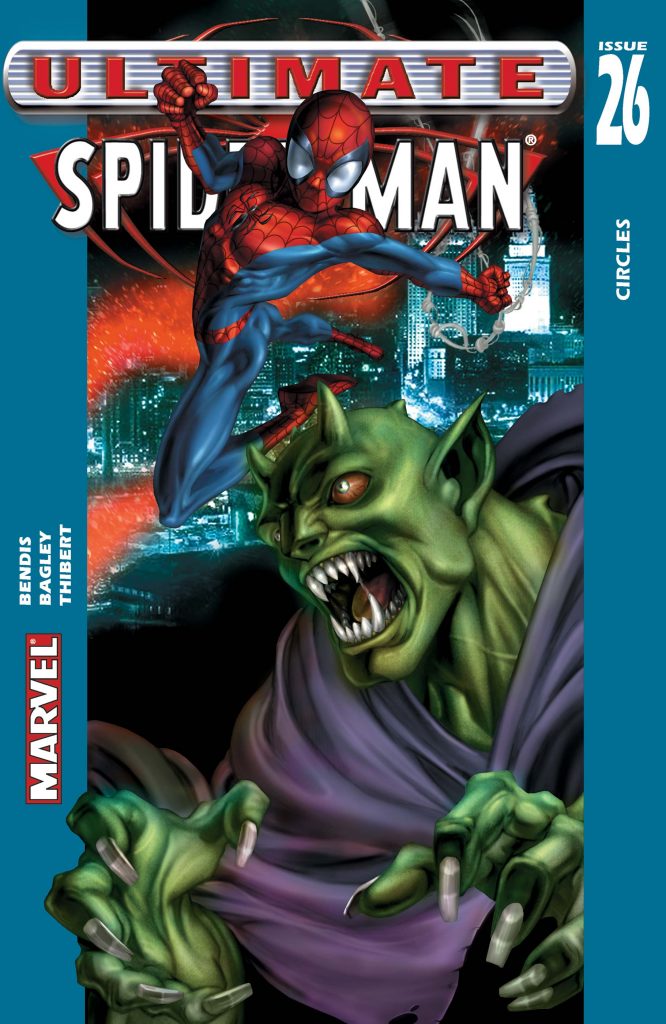
Ultimate Spider-Man
2002 found Ultimate Spider-Man square in the middle of what was a painfully long Doctor Octopus story. The story began in issue #14 and lasted until issue #21, and included several diversions to the main conflict. Rather than focusing on Spidey vs. Doc Ock, we also had Doc Ock vs. Justin Hammer, and Spidey vs. Ultimate Kraven, which was the real waste. Ultimate Kraven starts out as a take off of famed Aussie Crocodile Hunter Steve Irwin (this Kraven is also an Aussie, rather than a Slav, as in the original continuity), who comes to America to hunt Spider-Man, sack Ultimate Betty Brant (so much for her journalistic integrity) and then after incredible fanfare gets dropped by Spidey with one punch. However, it did provide the singularly most interesting panel of 2002. That Doc Ock, such a ladies man. Remember, this book is “for the kids.”
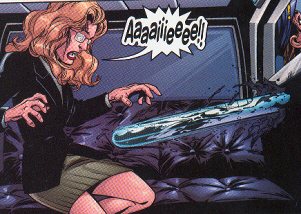
The return of the Ultimate Green Goblin, or should I say, the Hulk-Goblin was a marked improvement from the Doc Ock storyline and the first Hulk-Goblin story, in which Norman was simply an inarticulate monster. This time, Norman has regained his humanity and is able to transform himself back and forth from the Hulk-Goblin through injections of the Oz drug, which we now know was a failed super soldier formula that he was working on for SHIELD and Ultimate Nick Fury, or Ultimate Samuel L. Jackson, which he looks like. We get a better feel for the “big picture” of the Ultimate universe through the presence of Fury as well. Also, Bendis gives us the maniacal, manipulative Norman Osborn that we know and love, and even re-creates the ASM 121-122 confrontation with the Green Goblin, with Ultimate Mary Jane as the damsel in distress rather than “Skanky” Gwen Stacy (don’t get riled – that’s a takeoff of Kong calling her a “skank” as she’s definitely not the All-American Girl here). This time, Peter rescues MJ and therefore BOTH Ultimate MJ and Skanky Gwen are alive now, so Bendis used something familiar to send us into a different and unknown direction. Still, the Hulk-Goblin is the Hulk-Goblin, and a junkie Hulk-Goblin at that, driven mad by repeated use of the Oz drug. I just can’t see the villain as being as effective in the Ultimate continuity as he is in the “real” continuity.
After Ultimate Hulk-Goblin, we got an unremarkable short story arc (only three issues which is really short in Bendis-Bagley terms) involving a phoney Spider-Man, who is apparently not Ultimate Chameleon. What is significant in this story is that Bendis actually goes back to classic continuity and kills off Skanky Gwen’s father, Captain George Stacy before he even has a chance to get interested in Spider-Man and Peter Parker’s connection to him. So now, Skanky Gwen is actually living with Aunt May and Peter, another brand new twist on an old topic. It seemed to me that Aunt May was getting a bit younger and more attractive as the series progressed, and I was positive that it was happening so that she and Ultimate Captain Stacy, whose wife happened to leave both him and Skanky Gwen, could start becoming, uh, more familiar with each other. HOWEVER, I was wrong. Yep. Totally. No problem. I like being surprised.
And after repeated fan inquiries, Bendis finally broke down and created Ultimate Venom, the story which was still in process at the end of the year. Mercifully Bendis jettisoned the space alien aspect of the costume, and gave us an origin of the suit and a motivation for Eddie Brock (or should I say, Eddie Brock, Jr.) that each made much more sense than in the original continuity, and gives us some insight into Peter Parker’s father. This story is reviewed in the 2003 Year in Review.
Do I like the Ultimate series better than the original continuity? Of course not. Does it seem to be fulfilling a genuine purpose – of presenting another look at Spider-Man, rather than as a replacement for the original, as was once feared? Yeah, I guess. Is it interesting and well-done? Yes. Therefore, for all of its faults, Hulk-Goblin being a big one, I’ve made peace with Ultimate Spider-Man. I wrote that a long time ago. If you’ve read the 2005 Year in Review, I no longer feel that way.)
Spider-Girl
As if almost in his own little corner of the Marvel Universe, Tom DeFalco consistently continues to spin highly satisfying tales of the adventures of Peter Parker’s teen-age daughter May as she learns the ropes of the crime fighting business as Spider-Girl. By and large he has successfully integrated elements of the Clone Saga into his stories, bringing them to their logical resolution rather than what Marvel has done in the current continuity, which consists of ignoring it and hoping people will forget – fat chance. In 2002, we finally discover the exact moment where the regular continuity and Spider-Girl continuity diverge – and it’s (1) Kaine recovering Baby May from the Scriers and (2) Spidey confronting Norman Osborn at the Gathering of Five ceremony, a confrontation which results in Osborn’s final death and Spidey’s crippling accident. We also are introduced to Felicia Hardy’s and Flash Thompson’s daughter Felicity, who wants to hang around May as the new Scarlet Spider. Unlike regular continuity, where once the reboot occurred, Ben Reilly was largely forgotten – in the Spider-Girl Universe, the memory of Ben Reilly is very much present – which makes sense – one does not lose a brother and forget him.
DeFalco is also able to plug in references to his old Green Goblin series, as the older Phil Urich finally returns to the role, and he and May have to face one of his old villains, the psychotic Angel Face, this time accompanied by her children – the death of one which precipitates the blood feud between Angel Face and Spider-Girl.
One of the major plusses of this series is the routine interaction between an older Peter Parker and Johnny Storm, who still like to kid each other, but on the whole, their relationship seems to have truly evolved into a mature friendship. A few issues need to be resolved, like the fact that Darkdevil is really Reilly Tyne, the son of Ben Reilly, and yet no one is clued into that, not even Normie Osborn, who has seen Tyne, and yet doesn’t seem to notice how much he looks like a Parker. This is getting a little old. Another negative is that while Peter Parker’s high school life was a vital part of his original series, May’s high school interactions have for the most part been pretty dull – perhaps because she has another, more interesting social circle which revolves around Normie Osborn and the “New” New Warriors.
Of course, we know that Spider-Girl has been axed and saved at least once every three years. It has a relatively small, but loyal and vocal following, particularly in the internet community. I’m glad that for whatever reasons, Marvel has seen fit to allow this series to survive. It seems to be one of the few truly family friendly series out there – and one of the few to feature a female lead who keeps her clothes on and isn’t featured simply to titillate young male readers. It’s a series I felt perfectly comfortable allowing my 8 year old daughter (at the time this was originally written) to read and frankly, I think it’s a good feeding ground for interest in the original web slinger. One morning while watching one of the Spider-Man cartoons, my daughter asked “is there a Spider-Girl?” to which I was able to happily reply “yes.” If she’s interested in the adventures of the daughter at a young age, perhaps she’ll be interested in the original character where it all began as she gets older.
Other Stuff
Without a doubt, the weirdest Spidey story of the year happened to be the one shot satire by Peter Bagge called The Meglomaniacal Spider-Man. This was certainly not up everyone’s alley, and I sure hope that no one used this as an introduction into the world of Spider-Man, but all in all, this was a fun diversion for those who don’t take their Spidey too seriously. This time, in a bizarre alternate universe, Peter finds out that Uncle Ben was really a gambler and an overall scumbag, and that he was murdered because he first drew a gun on the infamous Burglar, who was actually there at the Parker house to collect a substantial gambling debt. As a result of learning this, the whole purpose of Spider-Man’s life is thrown into chaos. During a pitched battle with Doctor Octopus, he walks away from crime-fighting and Peter Parker becomes a greedy, self-absorbed corporate magnate and raider who treats everyone like crap, particularly J. Jonah Jameson, who now works for him since “Spider-Man, Inc.” purchased the Daily Bugle.
There’s a lot of funny stuff in this, particularly when a sobbing Doc Ock begs Spider-Man to come back and fight him because he doesn’t know what else to do – other than plot evil deeds and fight Spider-Man, and when CEO Peter Parker plays mind games with employee JJJ, who is hating every minute of having to kow tow to him. And I liked one fan’s characterization of the story as “What if Peter Parker had become Steve Ditko” since Peter discovers the work of Ayn Rand, much like Ditko did. But, as I said before, it isn’t for everyone, so caveat emptor.
Of course, the release of the Spider-Man movie coincided with the release of the Spider-Man movie adaption – written by the one and only Stan Lee. Frankly, the end product is something for completists only – in no small part due to the constraints of chronicling a two hour film and 100+ pages of script into only 50 pages of a comic book. And, it’s just too jarring seeing the movie versions of the characters depicted in a comic book. I might have been more interested in seeing the original comic versions of the characters act out the movie storyline. Norman Osborn is just not Norman Osborn in the comics without that funky red hair.
Best Story of the Year Hands down, no other story was even close to “A Death in the Family,” Paul Jenkins’s four-part take on the relationship between Norman Osborn and Peter Parker in Peter Parker #44-47. This is a rich and complex tale in which Jenkins has Osborn whip both Peter AND the readers into an absolute frenzy, leaving a doozy of a cliff-hanger at the end of the third part, and then pulling a surprise resolution that at first seems weird and awkward, but then makes sense upon further review. The resolution was somewhat controversial, and it was apparent that not all of the readers got it – or if they did get it, they disagreed that this is how Norman would behave or Peter would deal with the situation. But whether you liked it or not – give Jenkins credit for trying something different than simply having the two battle to the death – again – and either Norman appears to die, simply walks away, or loses his memory, all of which have been done before. This time, Norman is decisively beaten in a way he has never been beaten before.
Unfortunately the darkness of this story was completely undercut by the cartoony manga-influenced art of Humberto Ramos. It was completely inappropriate for this story. He’s fine for something like Out There, which is where I first saw his art, but not Spidey.
Worst Story of the YearAnd no, it isn’t Ron Zimmerman’s Get Kraven. As Nelson on The Simpsons would go “ha ha!” But it is Zimmerman’s “You can Call me Al” the backup story that was presented in its entirety in the first issue of Get Kraven. The biggest offense is “Al” confronting Spidey with knowledge of his secret identity and achieving a familiarity with Spidey that he doesn’t merit, particularly at the end when the two of them are starting to act like best buds. Barf. There are already too many people who know that Peter Parker is Spider-Man, and the discovery of said i.d. should be an important event within the story itself – and not some throwaway item geared solely to make us accept a particular character more than we otherwise might have. Oh, “Al” knows who Spidey is but doesn’t want to kill him or go after Aunt May – guess that makes him an o.k. guy. And then Zimmerman revives the Chameleon who as we all know, appeared to fall to a spectacular death at the end of Webspinners #11. Again, not that supervillains returning from the dead is that much of a novelty – but the nature of the Chameleon’s demise, particularly in view of his relationship with both Spider-Man and Peter Parker, which had been changing and growing more intense since the days just before the Clone Saga, should have been integrated into this story if he was going to return. The Chameleon that appeared to throw himself off the bridge at the end of the aforementioned Webspinners was a complex, seriously troubled, villain, not the cliched cackling madman in “You can Call me Al.” Another glaring ommission is that not even Spidey seems to remember the significance of their previous encounter. One of the reasons some of us are such continuity mavens is not because we like to obsess over every little detail (o.k., there is that..), but because a tightly adhered to continuity makes every story important in one way or another. Beyond the fact that this was simply not a very good story, it was clearly constructed with very little regard for what had been established before. And therefore, it’s a foregone conclusion that it, like Chapter One and “Captain Power,” will be completely ignored by any and all future writers, thus making it a complete waste of time.
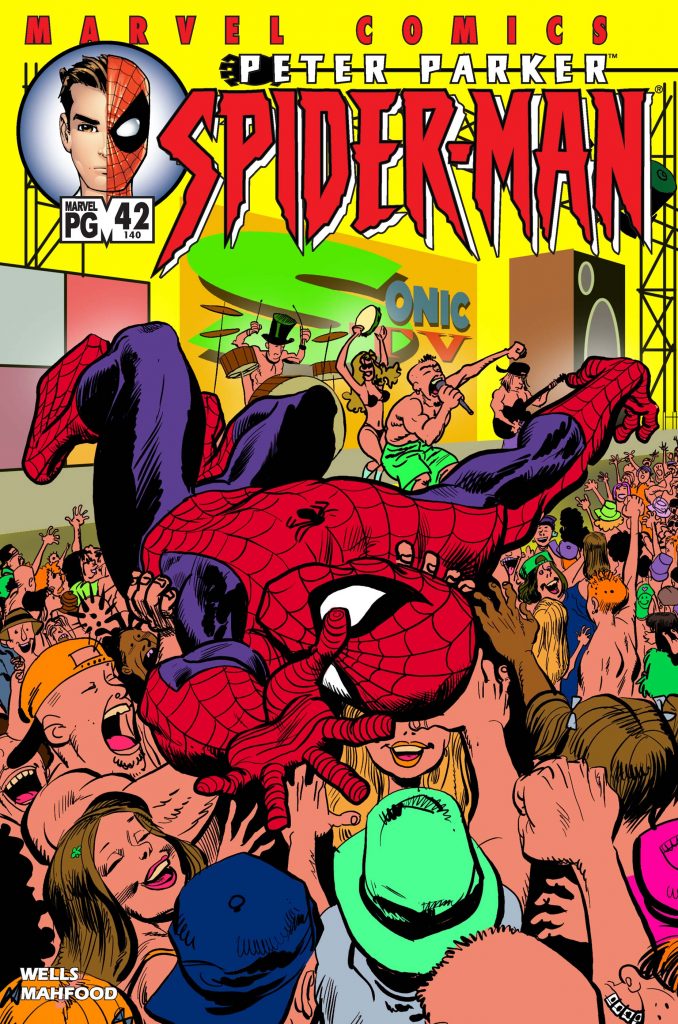
The runner-up for the worst story category was Zeb Wells’ MTV Beach Party story that ran in Peter Parker #42-43. Both Spidey and the Sandman appear off-kilter, as if we are reading about parallel universe versions of the two. Some character integrity seems to have been sacrificed for the humor in the story, which admittedly, is quite funny at times – but these issues seem to have a primary purpose of satirizing this kind of television, and the fact that Spider-Man is in it is irrelevant. In that case, it should have been presented as a stand-alone, as was Peter Bagge’s weird story. And the art, by Jim Mahfood, was just awful and completely inappropriate for Spider-Man. If you were a new reader and this is what you thought was representative of Spider-Man, then you were done a disservice.
The irony is, that after this, Wells completely redeemed himself with the excellent Tangled Web story “Behind the Moustache” (issue #20) featuring a look at JJJ like we had never seen before, including how Jonah falls in love with his first wife and his problematic relationship with his father that made Jonah the man he is today. The only lapse is the slightly weird father-figure spin that Wells tries to put on Jonah’s relationship with Spider-Man, but even experienced spider-writers often seem to have difficulty with the details of this very complex and thorny relationship. From that, Wells went on to a very acceptable run on Peter Parker, which really figures more in 2003’s year in review.
So, will 2003 represent another year of improvement in the spider titles – or has our favorite web head already peaked? Will the Ezekial-Morlun-Shathra-totem-mystical spider crap be brought to its conclusion? Will Mary Jane stay or will she leave again? What classic villain will next receive the “Ultimate” makeover? Will Spider-Girl be cancelled again?
Well…you could read my 2003 Year in Review..
from Spider Man Crawlspace https://ift.tt/37agqOp
https://ift.tt/30iZuEc
Facebook page
Popular Posts
-
On January 25th, 2020, Shanghai Disneyland closed to the public. Within months the rest of the worldwide Disney Parks closed in response t...
-
Aquaman v8 #58 - “Echoes of a Live Lived Well” (2020) pencil & ink by Miguel Mendonca color by Romulo Fajardo, Jr. from Comics and ...
-
Superman v5 #10 - “The House of El IV” (2019) pencil by Ivan Reis & Brandon Peterson ink by Ivan Reis, Joe Prado, Brandon Peterson, ...
Labels
Templateclue
Labels
Search This Blog
Blog Archive
- July 2020 (92)
- June 2020 (672)
- May 2020 (373)
- April 2020 (690)
- March 2020 (719)
- February 2020 (478)
About Me

- BLJ Mayank Blogger
- Web Devloper, Programmer, Script kiddies, Application Devloper, Blogger, Youtuber ...
Popular Posts
-
On January 25th, 2020, Shanghai Disneyland closed to the public. Within months the rest of the worldwide Disney Parks closed in response t...
-
Aquaman v8 #58 - “Echoes of a Live Lived Well” (2020) pencil & ink by Miguel Mendonca color by Romulo Fajardo, Jr. from Comics and ...
-
Superman v5 #10 - “The House of El IV” (2019) pencil by Ivan Reis & Brandon Peterson ink by Ivan Reis, Joe Prado, Brandon Peterson, ...
-
Batman: Last Knight on Earth #2 (2019) pencil by Greg Capullo ink by Jonathan Glapion color by FCO Plascencia from Comics and nothin...
-
HOUSE OF X and POWERS OF X continue to unfold, while Spider-Man, Black Widow, and from Comic Crusaders https://ift.tt/2wRt1Id https://ift...
-
Absolute Carnage v1 #1 (2019) textless page pencil by Ryan Stegman ink by J.P. Mayer color by Frank Martin Jr. from Comics and nothin...
-
Though we're going on about the fourth month of the COVID-19 pandemic, numbers of infected in a vast majority of the states in this coun...
-
The return of the Celestial Messiah to the Blue Area of the Moon sets off The post A GREAT INTERGALACTIC ALLIANCE HEADS TO EARTH IN THE EMP...
-
Batman/Superman v2 #4 - “Who Are the Secret Six? IV” (2019) pencil & ink by David Marquez color by Alejandro Sanchez from Comics an...
-
Red Sonja, paired with the half-vampire Chastity, is on the path to setting things right, The post PREVIEW: Red Sonja: Age of Chaos #3 app...
















